Recent Fire Damage Posts
Common Causes for House Fires
7/13/2024 (Permalink)
 House on Fire.
House on Fire.
A house can easily catch fire from the misuse of appliances and heating equipment to smoking in bedrooms. In Australia’s hot summer months, temperatures can soar past 40°C and teamed with a dry climate, conditions are ideal for fires to break out.
However you can take measures to avoid fire in home and ensure the safety of your family. Below are some of the most common causes of house fires, and some tips to take precautions.
1. Cooking Equipment
Pots and pans can overheat and cause a fire very easily if the person cooking gets distracted and leaves cooking unattended. Always stay in the room, or ask someone to watch your food, when cooking on hotplates.
2. Heating
Keep portable heaters at least one metre away from anything that could easily catch fire such as furniture, curtains, laundry, clothes and even yourself. If you have a furnace, get it inspected once a year to make sure it is working to safety standards.
3. Smoking in bedrooms
Bedrooms are best to be kept off limits for smoking. A cigarette that is not put out properly can cause a flame, as the butt may stay alit for a few hours. It could burst into flames if it came into contact with flammable materials, such as furniture. Did you know that fires started in the bedroom or lounge make up 73% of all house fire fatalities?¹
4. Electrical Equipment
An electrical appliance, such as a toaster can start a fire if it is faulty or has a frayed cord. A power point that is overloaded with double adapter plugs can cause a fire from an overuse of electricity. A power point extension cord can also be a fire hazard if not used appropriately. Double check the appliances and power points in your home.
5. Candles
Candles look and smell pretty, but if left unattended they can cause a room to easily burst into flames. Keep candles away from any obviously flammable items such as books and tissue boxes. Always blow a candle out before leaving a room. Did you know that in Perth last year 34 house fires started as a result of candles?²
6. Curious Children
Kids can cause a fire out of curiosity, to see what would happen if they set fire to an object. Keep any matches or lighters out of reach of children, to avoid any curiosity turned disaster. Install a smoke alarm in your child’s room and practice a home escape plan with your children and family in case there was a fire. Teach kids understand the “stop, drop, cover and roll” drill as well as knowing their address if they needed to call 000.
7. Faulty Wiring
Homes with inadequate wiring can cause fires from electrical hazards. Some signs to see if you’ve bad wiring are: 1) Lights dim if you use another appliance; 2) For an appliance to work, you have to disconnect another; 3) Fuses blow or trip the circuit frequently. Have a licenced electrician come and inspect you house, or contact your landlord if you have any of the above occurrences.
8. Barbeques
Barbeques are great for an outdoor meal, but should always be used away from the home, tablecloths or any plants and tree branches. Keep BBQs regularly maintained and cleaned with soapy water and clean any removable parts. Check the gas bottle for any leaks before you use it each time.
9. Flammable Liquids
If you have any flammable liquids in the home or garage such as petrol, kerosene or methylated spirits, keep them away from heat sources and check the label before storing. Be careful when pouring these liquids.
10. Lighting
Lamp shades and light fittings can build up heat if they are very close to light globes. Check around the house to make sure. Lamp bases can become a hazard if they are able to be knocked over easily, and so should be removed if they are. Check that down lights are insulated from wood panelling or ceiling timbers.
The above tips are a good guide to avoiding a fire in your home. However it’s a good idea to protect yourself with adequate home and content insurance, cover to ensure you are covered in the unlikely event a fire were to happen.
Source: https://www.realinsurance.com.au/news-views/the-most-common-causes-of-house-fires
How to Prevent House Fires
7/13/2024 (Permalink)
 Firefighters stopping House Fire.
Firefighters stopping House Fire.
Heating, holiday decorations, winter storms and candles all contribute to an increased risk of fire during the winter months.
NFPA and the United States Fire Administration (USFA) are teaming up to help reduce your risk to winter fires and other hazards, including carbon monoxide and electrical fires. Learn more about these specific elements of winter fire safety to help keep you safe this winter.
Heating
Heating is the second leading cause of U.S. home fires, deaths and injuries. December, January and February are the peak months for heating fires. Space heaters are the type of equipment most often involved in home heating equipment fires, figuring in two of every five fires (40%).
Carbon Monoxide
Often called the invisible killer, carbon monoxide (CO) is an odorless, colorless gas created when fuels such as gasoline, wood, coal, propane, etc. do not burn. In the home, heating and cooking equipment that burn fuel are potential sources of CO. Carbon Monoxide incidents are more common during the winter months, and in residential properties.
Winter storms
Most of the U.S. is at risk for winter storms, which can cause dangerous and sometimes life-threatening conditions. Blinding wind-driven snow, extreme cold, icy road conditions, downed trees and power lines can all wreak havoc on our daily schedules. Home fires occur more in the winter than in any other season, and heating equipment is involved in one of every six reported home fires, and one in every five home fire deaths.
Generators
Portable generators are useful during power outages, however, many homeowners are unaware that the improper use of portable generators can be risky. The most common dangers associated with portable generators are carbon monoxide (CO) poisoning, electrical shock or electrocution, and fire hazards.
According to a 2013 Consumer Product Safety Commission (CPSC) report, half of the generator-related deaths happened in the four coldest months of the year, November through February, and portable generators were involved in the majority of carbon monoxide deaths involving engine-driven tools.
Candles
December is the peak time of year for home candle fires; the top four days for home candle fires are New Year’s Day, Christmas, New Year’s Eve and Christmas Eve. Each year between 2009 and 2013, an average of 25 home candle fires were reported each day.
Electrical
Electrical home fires are a leading cause of home fires in the U.S. Roughly half of all home electrical fires involved electrical distribution or lighting equipment, while nearly another half involved other known types of equipment like washer or dryer fans, and portable or stationary space heaters.
Christmas tree disposal
Christmas trees are combustible items that become increasingly flammable as they continue to dry out in your home. Nearly 40 percent of home fires that begin with Christmas trees occur in January. Although Christmas tree fires are not common, when they do occur they’re much more likely to be serious.
Source: http://www.nfpa.org/public-education/campaigns/put-a-freeze-on-winter-fires
What Exactly is Fire Damage?
7/4/2024 (Permalink)
 Photo of fire damage in a kitchen.
Photo of fire damage in a kitchen.
What is fire damage?
A fire in your home can cause devastating damage and require you to act quickly to save as much of your valuable property as possible. There is also the possibility that your house may go up in flames, causing the surrounding area to be filled with smoke and fumes that can eventually be toxic. This article will outline what you should know about fire and the safety precautions you should take if home fires are to occur.
Why is Fire Risk in Your Home at High?
The factors that determine whether a home will be harmed by fire are many. However, those that appear to be most important are the air and heat in the rooms and the walls, combustible material in the home, a poorly constructed home, and age or damage at the attic level. The National Fire Protection Association, or NFFP, recommends to families that they avoid using open flames in all forms at any time, particularly in any heating system.
There are, however, times when open flames are needed or required for cooking and some other activities. This may come about from using open fires in the fireplace for heat or smoke, or due to open flames in a stove or a clothes washer. Also, if your kitchen is very small, then it may be worth giving consideration to using electric space heaters on the countertops rather than open flames. Another risk to consider is the use of open flames in a gas grill. While a gas grill can operate on a pilot flame and is considered safe in most instances, there is always the possibility that there may be an open flame in the grilling area of a gas grill.
The cost of fire damage.
A great number of fire incidents occur in the home. Many homeowners do not have any insurance on their home, or they have it for only a single year, but a couple of times they have insurance for the whole of their life. This is very important as you have to consider fire damage insurance in your life to save your house from financial ruin.
The most important thing is that you should not ignore fire and gas damage when they are occurring. In most cases, the insurance company will provide a minimum of coverage for fire and gas, but it does not mean it will cover fire damage completely. This is due to the fact that damage is subjective. It is not limited to how many homes a fire or gas strike has destroyed. Even if your home has been completely burnt down by fire, you still have to assess the damage. The best thing is, there are many fire damage insurance companies in the market today willing to pay for your claim, you just have to find the best deal possible.
The first thing to do is assess and inspect which areas are affected by the fire. This part is not so difficult, since you cannot see the extent of the fire damage.
Step 2: Check the property damage claim. Some insurance companies will not cover any damage to the inside of the house but do offer any property damage claims to the exterior of the house. If there is any damage to any areas that are not covered by all parties, the insurance company will be very helpful in calculating the damage and will get you the necessary compensation.
Step 3: Request a claim form from the insurance company. Many insurance companies make a claim form available to the homeowner. As you know, there will be a number of claims sent for the homeowner, there will also be a claim number corresponding to the claim number given by the insurance company
If you find yourself with fire damage. Please call SERVPRO®. We can help!
Read This if You Grill for the Holidays
6/29/2024 (Permalink)
 Someone starting up grill.
Someone starting up grill.
We all know that Holidays revolve around family, food, and friends. So we are sure there are going to be some grills fired up. It is good though to be safe and keep in mind that there are some best practices we want to share with you.
HOW TO PREVENT FLARE-UPS
Trim the fat.
Flare-ups usually happen because of excess fat, sauces or oily marinades. So trim as much excess fat as you can, without sacrificing flavor.
Keep the lid open.
When searing fatty foods, leave the grill lid opened.
Avoid wind.
Try to keep your grill away from windy areas. Wind forces oxygen between the grates, which can fuel a flare-up.
Move your food.
Try not to overcrowd your food on your grill. If a flare-up does happen, you want to be able to move your food away from the flame.
Burn the grease away.
During cooking, if grease pools, remove your food and turn the burners on high with the grill lid open until the grease has burned off.
Clean your grill.
Keeping your grill clean and maintained will help prevent the dreaded flare-up. Food residue and old grease are both great fuel for a fire, so removing debris after each use is important.
Turn off the burners.
If your grill flare-up is out of control, turn off the burners.
Don't use water.
You’ve heard the adage, “Oil and water don’t mix?” Well, that’s especially true for flare-ups. Spraying water on a flare-up can cause grease to explode. Don’t use it.
However, we know accidents happen. That is why SERVPRO is here. To help you if your grill or anything else was to catch your home on fire.
Your Dryer can also Catch on Fire
6/29/2024 (Permalink)
 Dryer in a pile of debris.
Dryer in a pile of debris.
Why do dryers catch on fire?
My clothes still need doing, and I still find time on even my busiest day to do so. But it is at these moments that we sometimes forget about the dryers.
Not because it is so often at just such a time but because the dryers are so dangerous. That is why it is important to keep up with tips and strategies to prevent dryer fires. To that end, we have to remember that dryers are like appliances that are set to work as part of the daily laundry cycle and thus use a few small parts to ignite.
Here are a couple of things to remember:
Why you don't leave the dryer going when no one is home?
Why you don't leave the dryer going when no one is home.
A big reason to prevent dryer fires is that the fire often leads to a second or third fire or can be a safety hazard. It's always better to prevent a fire than to respond to a fire situation.
Before dryer fires occur, we usually have a fire hazard situation. If you have a hot water pipe in your kitchen and a fire could start there, use a fire extinguisher. A fire extinguisher can be used effectively to save your property from dryer fires. A fire extinguisher can also be used effectively to extinguish and prevent a fire from occurring at a dryer.
How to clean the dryer lint.
The heat from the dryer is always intense. The machine uses a large heat capacity to absorb the heat, leaving the dryer lint sitting on top of the inside of the machine after every cycle. You'll notice that the top of the dryer is always smeared with dryer lint and what is left over after the dryer door closes. The lint can cause a fire. How to minimize this risk?
Simply make sure you throw away the lint from the lint filter after every use.
But if this does happen and you end up with fire damage. Please call SERVPRO. We can help.
Your Dryer can also Catch on Fire
6/29/2024 (Permalink)
 Dryer in a pile of debris.
Dryer in a pile of debris.
Why do dryers catch on fire?
My clothes still need doing, and I still find time on even my busiest day to do so. But it is at these moments that we sometimes forget about the dryers.
Not because it is so often at just such a time but because the dryers are so dangerous. That is why it is important to keep up with tips and strategies to prevent dryer fires. To that end, we have to remember that dryers are like appliances that are set to work as part of the daily laundry cycle and thus use a few small parts to ignite.
Here are a couple of things to remember:
Why you don't leave the dryer going when no one is home?
Why you don't leave the dryer going when no one is home.
A big reason to prevent dryer fires is that the fire often leads to a second or third fire or can be a safety hazard. It's always better to prevent a fire than to respond to a fire situation.
Before dryer fires occur, we usually have a fire hazard situation. If you have a hot water pipe in your kitchen and a fire could start there, use a fire extinguisher. A fire extinguisher can be used effectively to save your property from dryer fires. A fire extinguisher can also be used effectively to extinguish and prevent a fire from occurring at a dryer.
How to clean the dryer lint.
The heat from the dryer is always intense. The machine uses a large heat capacity to absorb the heat, leaving the dryer lint sitting on top of the inside of the machine after every cycle. You'll notice that the top of the dryer is always smeared with dryer lint and what is left over after the dryer door closes. The lint can cause a fire. How to minimize this risk?
Simply make sure you throw away the lint from the lint filter after every use.
But if this does happen and you end up with fire damage. Please call SERVPRO. We can help.
Do Your Smoker Detectors Work?
6/24/2024 (Permalink)
 Smoke Detector surrounded by smoke.
Smoke Detector surrounded by smoke.
When it comes to your family's safety, smoke detectors, and fire alarms can be some of the most important items in your home. These early warning devices can alert your family to fire and hazardous smoke while there is still time to evacuate, but they should be tested periodically to ensure they are working properly.
Electronic devices are not faultless. The batteries will die and other parts of the smoke alarm can wear out over time. Regularly testing them and replacing the batteries (or the entire device) can help keep your family safe in the event of a house fire.
Be sure to read your smoke detector's owner's manual - you may need to check more often if any of the following apply: The detector often gives false alarms.
The alarm emits short beeps regularly without anyone touching it.
Frequent kitchen fumes often activate it, which can cause it to wear out faster.
For battery-operated: This type may be prone to defective or worn-out batteries. Monthly tests are very important.
Never put old batteries in your smoke detectors and fire detectors. Wired: These detectors are powered by your home's electrical system, but they usually have backup batteries so the device stays operational in the event of a power outage.
Wired smoke alarms should still be tested monthly to ensure both batteries and components are working properly.
You should always check the manufacturer's instructions for the correct test method for your smoke detector and fire alarm.
You may want to install additional detectors in areas where the alarm sound is low, muffled or weak. Press and hold the test button on the smoke detector. It may take a few seconds to go off, but a loud, deafening siren should come out of the smoke detector when the button is pressed. If not, then replace it.
If it has been more than six months since you last changed the batteries (whether your detector is battery-powered or wired), replace it now and test the new batteries one last time to ensure they are working properly, regardless of the test result.
You should also look at your smoke alarm to make sure it's not dust or any other substance blocking the grilles and causing it to not work even if the batteries are new. Note that smoke detectors typically have a 10-year lifespan.
Now that you know how to prevent your fire alarms from not working, do keep in mind that if they are not working correctly this can cause a house fire. We don't want this to happen at all, but if it does SERVPRO is here to help! We do fire damage remediation at its best.
10 Common Causes for House Fires
7/13/2023 (Permalink)
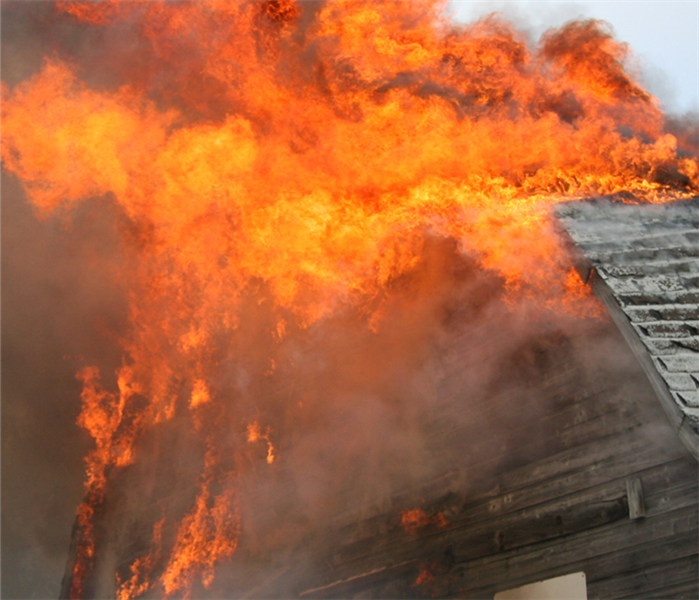 Winter house fire.
Winter house fire.
A house can easily catch fire from the misuse of appliances and heating equipment to smoking in bedrooms. In Australia’s hot summer months, temperatures can soar past 40°C and teamed with a dry climate, conditions are ideal for fires to break out.
However you can take measures to avoid fire in home and ensure the safety of your family. Below are some of the most common causes of house fires, and some tips to take precautions.
1. Cooking Equipment
Pots and pans can overheat and cause a fire very easily if the person cooking gets distracted and leaves cooking unattended. Always stay in the room, or ask someone to watch your food, when cooking on hotplates.
2. Heating
Keep portable heaters at least one metre away from anything that could easily catch fire such as furniture, curtains, laundry, clothes and even yourself. If you have a furnace, get it inspected once a year to make sure it is working to safety standards.
3. Smoking in bedrooms
Bedrooms are best to be kept off limits for smoking. A cigarette that is not put out properly can cause a flame, as the butt may stay alit for a few hours. It could burst into flames if it came into contact with flammable materials, such as furniture. Did you know that fires started in the bedroom or lounge make up 73% of all house fire fatalities?¹
4. Electrical Equipment
An electrical appliance, such as a toaster can start a fire if it is faulty or has a frayed cord. A power point that is overloaded with double adapter plugs can cause a fire from an overuse of electricity. A power point extension cord can also be a fire hazard if not used appropriately. Double check the appliances and power points in your home.
5. Candles
Candles look and smell pretty, but if left unattended they can cause a room to easily burst into flames. Keep candles away from any obviously flammable items such as books and tissue boxes. Always blow a candle out before leaving a room. Did you know that in Perth last year 34 house fires started as a result of candles?²
6. Curious Children
Kids can cause a fire out of curiosity, to see what would happen if they set fire to an object. Keep any matches or lighters out of reach of children, to avoid any curiosity turned disaster. Install a smoke alarm in your child’s room and practice a home escape plan with your children and family in case there was a fire. Teach kids understand the “stop, drop, cover and roll” drill as well as knowing their address if they needed to call 000.
7. Faulty Wiring
Homes with inadequate wiring can cause fires from electrical hazards. Some signs to see if you’ve bad wiring are: 1) Lights dim if you use another appliance; 2) For an appliance to work, you have to disconnect another; 3) Fuses blow or trip the circuit frequently. Have a licenced electrician come and inspect you house, or contact your landlord if you have any of the above occurrences.
8. Barbeques
Barbeques are great for an outdoor meal, but should always be used away from the home, tablecloths or any plants and tree branches. Keep BBQs regularly maintained and cleaned with soapy water and clean any removable parts. Check the gas bottle for any leaks before you use it each time.
9. Flammable Liquids
If you have any flammable liquids in the home or garage such as petrol, kerosene or methylated spirits, keep them away from heat sources and check the label before storing. Be careful when pouring these liquids.
10. Lighting
Lamp shades and light fittings can build up heat if they are very close to light globes. Check around the house to make sure. Lamp bases can become a hazard if they are able to be knocked over easily, and so should be removed if they are. Check that down lights are insulated from wood panelling or ceiling timbers.
The above tips are a good guide to avoiding a fire in your home. However it’s a good idea to protect yourself with adequate home and content insurance, cover to ensure you are covered in the unlikely event a fire were to happen.
Source: https://www.realinsurance.com.au/news-views/the-most-common-causes-of-house-fires
How to Prevent Winter Fires from Occurring
7/13/2023 (Permalink)
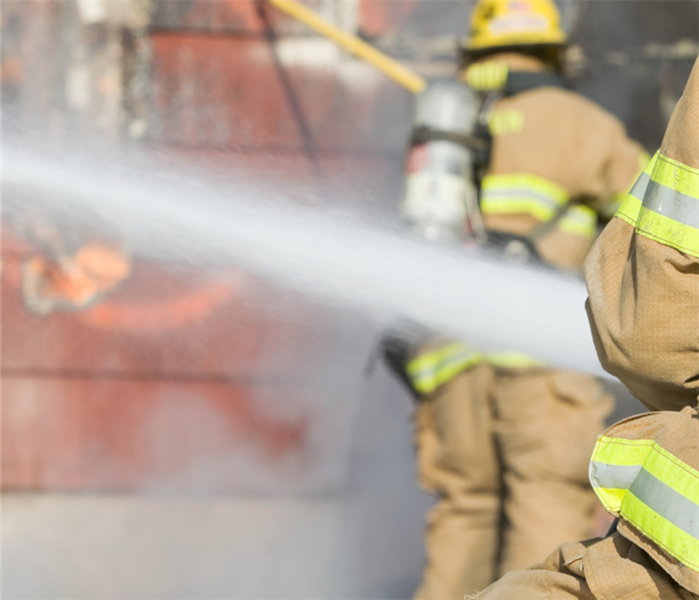 Put an end to winter fires.
Put an end to winter fires.
Heating, holiday decorations, winter storms and candles all contribute to an increased risk of fire during the winter months.
NFPA and the United States Fire Administration (USFA) are teaming up to help reduce your risk to winter fires and other hazards, including carbon monoxide and electrical fires. Learn more about these specific elements of winter fire safety to help keep you safe this winter.
Heating
Heating is the second leading cause of U.S. home fires, deaths and injuries. December, January and February are the peak months for heating fires. Space heaters are the type of equipment most often involved in home heating equipment fires, figuring in two of every five fires (40%).
Carbon Monoxide
Often called the invisible killer, carbon monoxide (CO) is an odorless, colorless gas created when fuels such as gasoline, wood, coal, propane, etc. do not burn. In the home, heating and cooking equipment that burn fuel are potential sources of CO. Carbon Monoxide incidents are more common during the winter months, and in residential properties.
Winter storms
Most of the U.S. is at risk for winter storms, which can cause dangerous and sometimes life-threatening conditions. Blinding wind-driven snow, extreme cold, icy road conditions, downed trees and power lines can all wreak havoc on our daily schedules. Home fires occur more in the winter than in any other season, and heating equipment is involved in one of every six reported home fires, and one in every five home fire deaths.
Generators
Portable generators are useful during power outages, however, many homeowners are unaware that the improper use of portable generators can be risky. The most common dangers associated with portable generators are carbon monoxide (CO) poisoning, electrical shock or electrocution, and fire hazards.
According to a 2013 Consumer Product Safety Commission (CPSC) report, half of the generator-related deaths happened in the four coldest months of the year, November through February, and portable generators were involved in the majority of carbon monoxide deaths involving engine-driven tools.
Candles
December is the peak time of year for home candle fires; the top four days for home candle fires are New Year’s Day, Christmas, New Year’s Eve and Christmas Eve. Each year between 2009 and 2013, an average of 25 home candle fires were reported each day.
Electrical
Electrical home fires are a leading cause of home fires in the U.S. Roughly half of all home electrical fires involved electrical distribution or lighting equipment, while nearly another half involved other known types of equipment like washer or dryer fans, and portable or stationary space heaters.
Christmas tree disposal
Christmas trees are combustible items that become increasingly flammable as they continue to dry out in your home. Nearly 40 percent of home fires that begin with Christmas trees occur in January. Although Christmas tree fires are not common, when they do occur they’re much more likely to be serious.
Source: http://www.nfpa.org/public-education/campaigns/put-a-freeze-on-winter-fires
Exactly What Is Fire Damage?
7/4/2023 (Permalink)
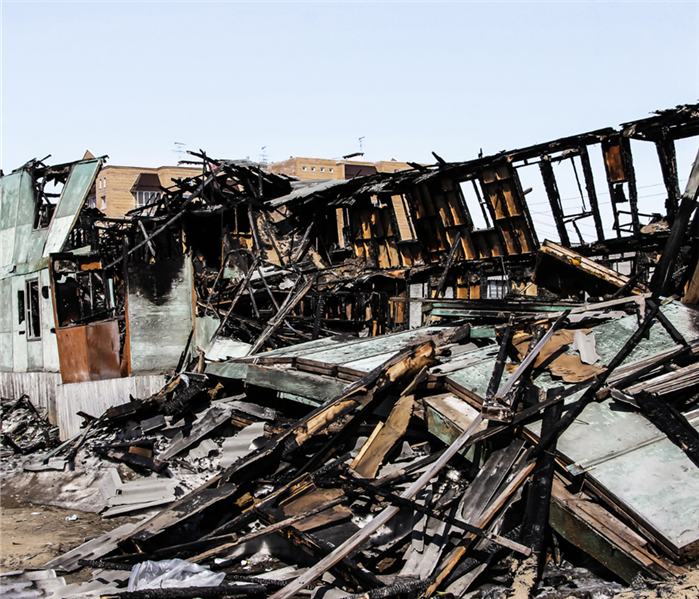 The remaining aftermath of a house fire.
The remaining aftermath of a house fire.
What is fire damage?
A fire in your home can cause devastating damage and require you to act quickly to save as much of your valuable property as possible. There is also the possibility that your house may go up in flames, causing the surrounding area to be filled with smoke and fumes that can eventually be toxic. This article will outline what you should know about fire and the safety precautions you should take if home fires are to occur.
Why is Fire Risk in Your Home at High?
The factors that determine whether a home will be harmed by fire are many. However, those that appear to be most important are the air and heat in the rooms and the walls, combustible material in the home, a poorly constructed home, and age or damage at the attic level. The National Fire Protection Association, or NFFP, recommends to families that they avoid using open flames in all forms at any time, particularly in any heating system.
There are, however, times when open flames are needed or required for cooking and some other activities. This may come about from using open fires in the fireplace for heat or smoke, or due to open flames in a stove or a clothes washer. Also, if your kitchen is very small, then it may be worth giving consideration to using electric space heaters on the countertops rather than open flames. Another risk to consider is the use of open flames in a gas grill. While a gas grill can operate on a pilot flame and is considered safe in most instances, there is always the possibility that there may be an open flame in the grilling area of a gas grill.
The cost of fire damage.
A great number of fire incidents occur in the home. Many homeowners do not have any insurance on their home, or they have it for only a single year, but a couple of times they have insurance for the whole of their life. This is very important as you have to consider fire damage insurance in your life to save your house from financial ruin.
The most important thing is that you should not ignore fire and gas damage when they are occurring. In most cases, the insurance company will provide a minimum of coverage for fire and gas, but it does not mean it will cover fire damage completely. This is due to the fact that damage is subjective. It is not limited to how many homes a fire or gas strike has destroyed. Even if your home has been completely burnt down by fire, you still have to assess the damage. The best thing is, there are many fire damage insurance companies in the market today willing to pay for your claim, you just have to find the best deal possible.
The first thing to do is assess and inspect which areas are affected by the fire. This part is not so difficult, since you cannot see the extent of the fire damage.
Step 2: Check the property damage claim. Some insurance companies will not cover any damage to the inside of the house but do offer any property damage claims to the exterior of the house. If there is any damage to any areas that are not covered by all parties, the insurance company will be very helpful in calculating the damage and will get you the necessary compensation.
Step 3: Request a claim form from the insurance company. Many insurance companies make a claim form available to the homeowner. As you know, there will be a number of claims sent for the homeowner, there will also be a claim number corresponding to the claim number given by the insurance company
If you find yourself with fire damage. Please call SERVPRO. We can help!
Are The Smoke Detectors Working In Your Home?
6/29/2023 (Permalink)
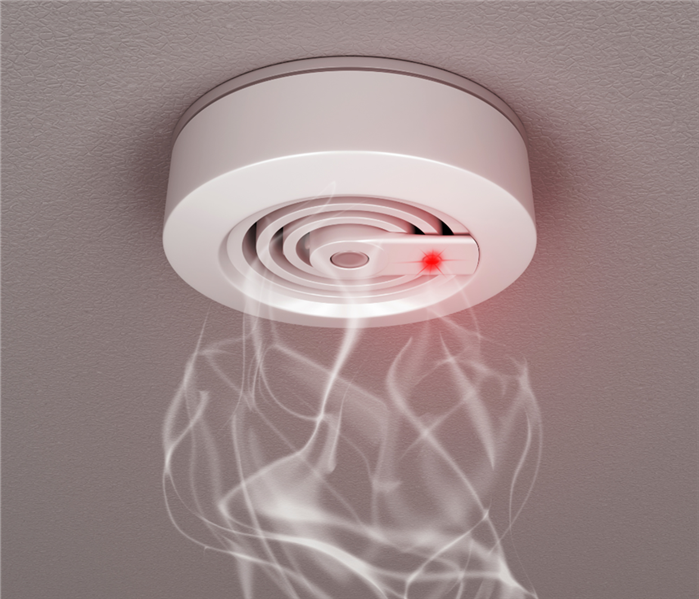 A photo of a smoke detector at work.
A photo of a smoke detector at work.
When it comes to your family's safety, smoke detectors, and fire alarms can be some of the most important items in your home. These early warning devices can alert your family to fire and hazardous smoke while there is still time to evacuate, but they should be tested periodically to ensure they are working properly.
Electronic devices are not faultless. The batteries will die and other parts of the smoke alarm can wear out over time. Regularly testing them and replacing the batteries (or the entire device) can help keep your family safe in the event of a house fire.
Be sure to read your smoke detector's owner's manual - you may need to check more often if any of the following apply: The detector often gives false alarms.
The alarm emits short beeps regularly without anyone touching it.
Frequent kitchen fumes often activate it, which can cause it to wear out faster.
For battery-operated: This type may be prone to defective or worn-out batteries. Monthly tests are very important.
Never put old batteries in your smoke detectors and fire detectors. Wired: These detectors are powered by your home's electrical system, but they usually have backup batteries so the device stays operational in the event of a power outage.
Wired smoke alarms should still be tested monthly to ensure both batteries and components are working properly.
You should always check the manufacturer's instructions for the correct test method for your smoke detector and fire alarm.
You may want to install additional detectors in areas where the alarm sound is low, muffled or weak. Press and hold the test button on the smoke detector. It may take a few seconds to go off, but a loud, deafening siren should come out of the smoke detector when the button is pressed. If not, then replace it.
If it has been more than six months since you last changed the batteries (whether your detector is battery-powered or wired), replace it now and test the new batteries one last time to ensure they are working properly, regardless of the test result.
You should also look at your smoke alarm to make sure it's not dust or any other substance blocking the grilles and causing it to not work even if the batteries are new. Note that smoke detectors typically have a 10-year lifespan.
Now that you know how to prevent your fire alarms from not working, do keep in mind that if they are not working correctly this can cause a house fire. We don't want this to happen at all, but if it does SERVPRO is here to help! We do fire damage remediation at its best.
Anything Can Catch On Fire, Even Your Dryer
6/29/2023 (Permalink)
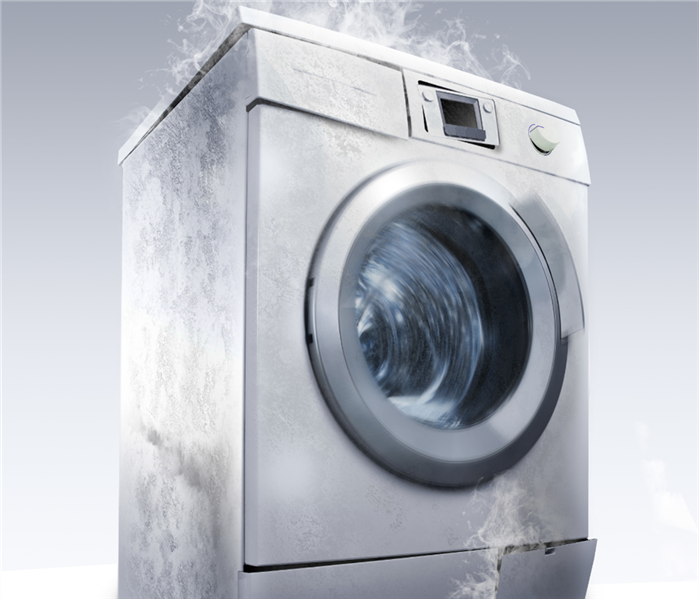 A clothes dryer smoking.
A clothes dryer smoking.
Why do dryers catch on fire?
My clothes still need doing, and I still find time on even my busiest day to do so. But it is at these moments that we sometimes forget about the dryers.
Not because it is so often at just such a time but because the dryers are so dangerous. That is why it is important to keep up with tips and strategies to prevent dryer fires. To that end, we have to remember that dryers are like appliances that are set to work as part of the daily laundry cycle and thus use a few small parts to ignite.
Here are a couple of things to remember:
Why you don't leave the dryer going when no one is home?
Why you don't leave the dryer going when no one is home.
A big reason to prevent dryer fires is that the fire often leads to a second or third fire or can be a safety hazard. It's always better to prevent a fire than to respond to a fire situation.
Before dryer fires occur, we usually have a fire hazard situation. If you have a hot water pipe in your kitchen and a fire could start there, use a fire extinguisher. A fire extinguisher can be used effectively to save your property from dryer fires. A fire extinguisher can also be used effectively to extinguish and prevent a fire from occurring at a dryer.
How to clean the dryer lint.
The heat from the dryer is always intense. The machine uses a large heat capacity to absorb the heat, leaving the dryer lint sitting on top of the inside of the machine after every cycle. You'll notice that the top of the dryer is always smeared with dryer lint and what is left over after the dryer door closes. The lint can cause a fire. How to minimize this risk?
Simply make sure you throw away the lint from the lint filter after every use.
But if this does happen and you end up with fire damage. Please call SERVPRO. We can help.
Do You Grill For The Holidays? Read This.
6/29/2023 (Permalink)
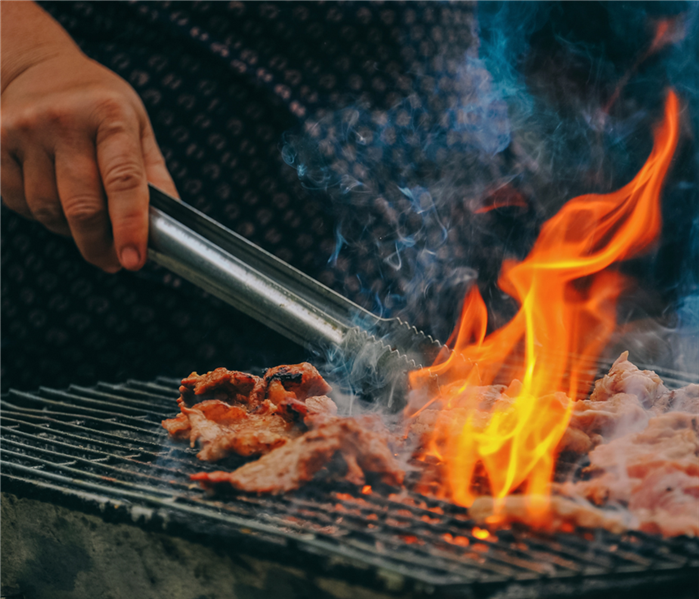 A man grilling out with a fire flare-up happening.
A man grilling out with a fire flare-up happening.
We all know that Holidays revolve around family, food, and friends. So we are sure there are going to be some grills fired up. It is good though to be safe and keep in mind that there are some best practices we want to share with you.
HOW TO PREVENT FLARE-UPS
Trim the fat.
Flare-ups usually happen because of excess fat, sauces or oily marinades. So trim as much excess fat as you can, without sacrificing flavor.
Keep the lid open.
When searing fatty foods, leave the grill lid opened.
Avoid wind.
Try to keep your grill away from windy areas. Wind forces oxygen between the grates, which can fuel a flare-up.
Move your food.
Try not to overcrowd your food on your grill. If a flare-up does happen, you want to be able to move your food away from the flame.
Burn the grease away.
During cooking, if grease pools, remove your food and turn the burners on high with the grill lid open until the grease has burned off.
Clean your grill.
Keeping your grill clean and maintained will help prevent the dreaded flare-up. Food residue and old grease are both great fuel for a fire, so removing debris after each use is important.
Turn off the burners.
If your grill flare-up is out of control, turn off the burners.
Don't use water.
You’ve heard the adage, “Oil and water don’t mix?” Well, that’s especially true for flare-ups. Spraying water on a flare-up can cause grease to explode. Don’t use it.
However, we know accidents happen. That is why SERVPRO is here. To help you if your grill or anything else was to catch your home on fire.
Stop Winter Fires from Occurring
7/14/2022 (Permalink)
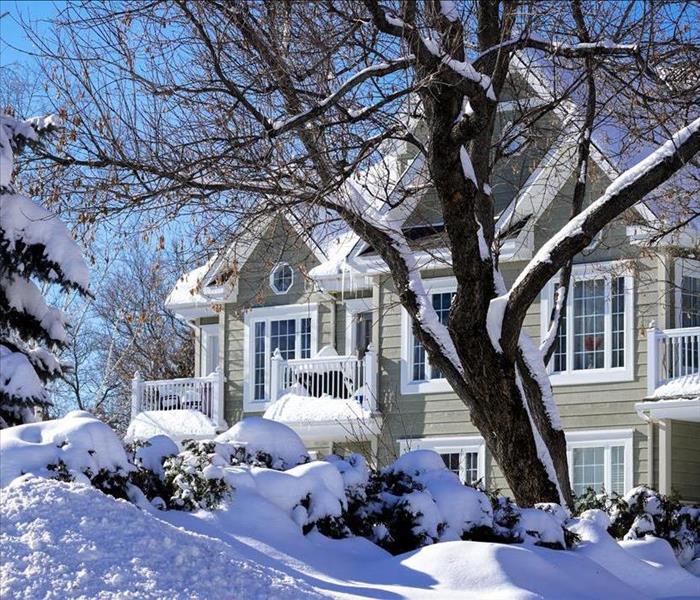 Put an end to winter fires.
Put an end to winter fires.
Heating, holiday decorations, winter storms and candles all contribute to an increased risk of fire during the winter months.
NFPA and the United States Fire Administration (USFA) are teaming up to help reduce your risk to winter fires and other hazards, including carbon monoxide and electrical fires. Learn more about these specific elements of winter fire safety to help keep you safe this winter.
Heating
Heating is the second leading cause of U.S. home fires, deaths and injuries. December, January and February are the peak months for heating fires. Space heaters are the type of equipment most often involved in home heating equipment fires, figuring in two of every five fires (40%).
Carbon Monoxide
Often called the invisible killer, carbon monoxide (CO) is an odorless, colorless gas created when fuels such as gasoline, wood, coal, propane, etc. do not burn. In the home, heating and cooking equipment that burn fuel are potential sources of CO. Carbon Monoxide incidents are more common during the winter months, and in residential properties.
Winter storms
Most of the U.S. is at risk for winter storms, which can cause dangerous and sometimes life-threatening conditions. Blinding wind-driven snow, extreme cold, icy road conditions, downed trees and power lines can all wreak havoc on our daily schedules. Home fires occur more in the winter than in any other season, and heating equipment is involved in one of every six reported home fires, and one in every five home fire deaths.
Generators
Portable generators are useful during power outages, however, many homeowners are unaware that the improper use of portable generators can be risky. The most common dangers associated with portable generators are carbon monoxide (CO) poisoning, electrical shock or electrocution, and fire hazards.
According to a 2013 Consumer Product Safety Commission (CPSC) report, half of the generator-related deaths happened in the four coldest months of the year, November through February, and portable generators were involved in the majority of carbon monoxide deaths involving engine-driven tools.
Candles
December is the peak time of year for home candle fires; the top four days for home candle fires are New Year’s Day, Christmas, New Year’s Eve and Christmas Eve. Each year between 2009 and 2013, an average of 25 home candle fires were reported each day.
Electrical
Electrical home fires are a leading cause of home fires in the U.S. Roughly half of all home electrical fires involved electrical distribution or lighting equipment, while nearly another half involved other known types of equipment like washer or dryer fans, and portable or stationary space heaters.
Christmas tree disposal
Christmas trees are combustible items that become increasing flammable as they continue to dry out in your home. Nearly 40 percent of home fires that begin with Christmas trees occur in January. Although Christmas tree fires are not common, when they do occur they’re much more likely to be serious.
Source: http://www.nfpa.org/public-education/campaigns/put-a-freeze-on-winter-fires
Common Causes for House Fires
7/14/2022 (Permalink)
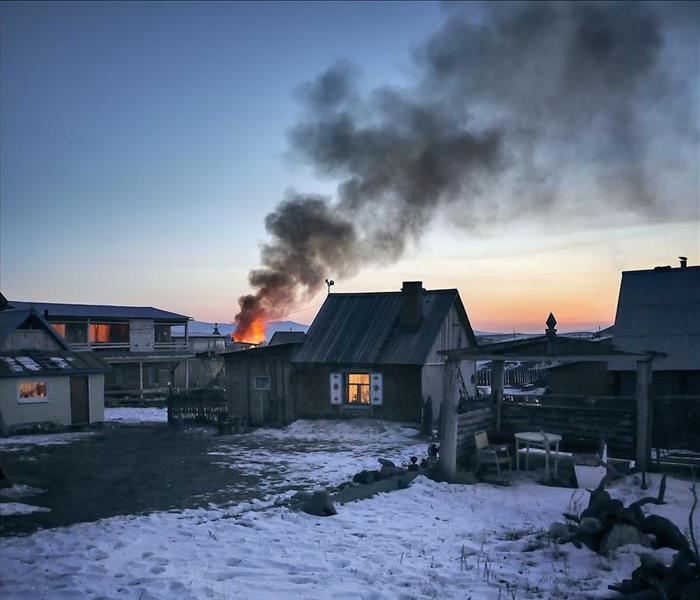 Winter house fire.
Winter house fire.
A house can easily catch fire from the misuse of appliances and heating equipment to smoking in bedrooms. In Australia’s hot summer months, temperatures can soar past 40°C and teamed with a dry climate, conditions are ideal for fires to break out.
However you can take measures to avoid fire in home and ensure the safety of your family. Below are some of the most common causes of house fires, and some tips to take precautions.
1. Cooking Equipment
Pots and pans can overheat and cause a fire very easily if the person cooking gets distracted and leaves cooking unattended. Always stay in the room, or ask someone to watch your food, when cooking on hotplates.
2. Heating
Keep portable heaters at least one metre away from anything that could easily catch fire such as furniture, curtains, laundry, clothes and even yourself. If you have a furnace, get it inspected once a year to make sure it is working to safety standards.
3. Smoking in bedrooms
Bedrooms are best to be kept off limits for smoking. A cigarette that is not put out properly can cause a flame, as the butt may stay alit for a few hours. It could burst into flames if it came into contact with flammable materials, such as furniture. Did you know that fires started in the bedroom or lounge make up 73% of all house fire fatalities?¹
4. Electrical Equipment
An electrical appliance, such as a toaster can start a fire if it is faulty or has a frayed cord. A power point that is overloaded with double adapter plugs can cause a fire from an overuse of electricity. A power point extension cord can also be a fire hazard if not used appropriately. Double check the appliances and power points in your home.
5. Candles
Candles look and smell pretty, but if left unattended they can cause a room to easily burst into flames. Keep candles away from any obviously flammable items such as books and tissue boxes. Always blow a candle out before leaving a room. Did you know that in Perth last year 34 house fires started as a result of candles?²
6. Curious Children
Kids can cause a fire out of curiosity, to see what would happen if they set fire to an object. Keep any matches or lighters out of reach of children, to avoid any curiosity turned disaster. Install a smoke alarm in your child’s room and practice a home escape plan with your children and family in case there was a fire. Teach kids understand the “stop, drop, cover and roll” drill as well as knowing their address if they needed to call 000.
7. Faulty Wiring
Homes with inadequate wiring can cause fires from electrical hazards. Some signs to see if you’ve bad wiring are: 1) Lights dim if you use another appliance; 2) For an appliance to work, you have to disconnect another; 3) Fuses blow or trip the circuit frequently. Have a licenced electrician come and inspect you house, or contact your landlord if you have any of the above occurrences.
8. Barbeques
Barbeques are great for an outdoor meal, but should always be used away from the home, tablecloths or any plants and tree branches. Keep BBQs regularly maintained and cleaned with soapy water and clean any removable parts. Check the gas bottle for any leaks before you use it each time.
9. Flammable Liquids
If you have any flammable liquids in the home or garage such as petrol, kerosene or methylated spirits, keep them away from heat sources and check the label before storing. Be careful when pouring these liquids.
10. Lighting
Lamp shades and light fittings can build up heat if they are very close to light globes. Check around the house to make sure. Lamp bases can become a hazard if they are able to be knocked over easily, and so should be removed if they are. Check that down lights are insulated from wood panelling or ceiling timbers.
The above tips are a good guide to avoiding a fire in your home. However it’s a good idea to protect yourself with adequate home and content insurance, cover to ensure you are covered in the unlikely event a fire were to happen.
Source: https://www.realinsurance.com.au/news-views/the-most-common-causes-of-house-fires
Grilling for the Holidays?
7/1/2022 (Permalink)
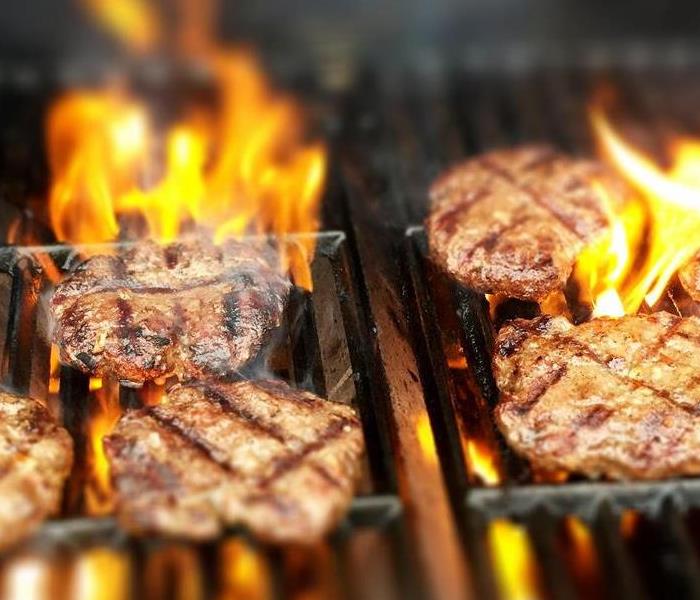 A man grilling out with a fire flare up happening.
A man grilling out with a fire flare up happening.
We all know that Holidays revolve around family, food, and friends. So we are sure there are going to be some grills fired up. It is good though to be safe and keep in mind that there are some best practices we want to share with you.
HOW TO PREVENT FLARE-UPS
Trim the fat.
Flare-ups usually happen because of excess fat, sauces or oily marinades. So trim as much excess fat as you can, without sacrificing flavor.
Keep the lid open.
When searing fatty foods, leave the grill lid opened.
Avoid wind.
Try to keep your grill away from windy areas. Wind forces oxygen between the grates, which can fuel a flare-up.
Move your food.
Try not to overcrowd your food on your grill. If a flare-up does happen, you want to be able to move your food away from the flame.
Burn the grease away.
During cooking, if grease pools, remove your food and turn the burners on high with the grill lid open until grease has burned off.
Clean your grill.
Keeping your grill clean and maintained will help prevent the dreaded flare-up. Food residue and old grease are both great fuel for a fire, so removing debris after each use is important.
Turn off the burners.
If your grill flare-up is out-of-control, turn off the burners.
Don't use water.
You’ve heard the adage, “Oil and water don’t mix?” Well that’s especially true for flare-ups. Spraying water on a flare-up can cause grease to explode. Don’t use it.
However, we know accidents happen. That is why SERVPRO is here. To help you if your grill or anything else was to catch your home on fire.
Dryers Can Catch on Fire
7/1/2022 (Permalink)
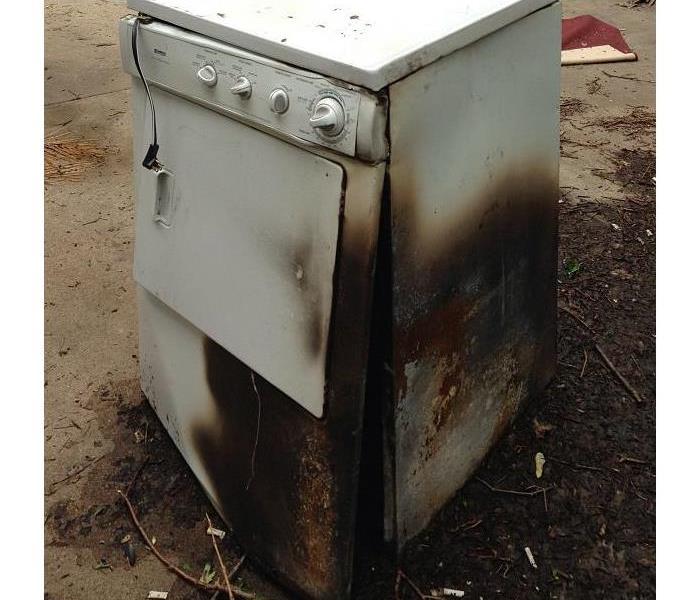 The dryer has caught on fire and been put out. Leaving it fire and smoke damage.
The dryer has caught on fire and been put out. Leaving it fire and smoke damage.
Why dryers catch on fire.
My clothes still need doing, and I still find time in even my busiest day to do so. But it is at these moments that we sometimes forget about the dryers.
Not because it is so often at just such a time but because the dryers are so dangerous. That is why it is important to keep up with tips and strategies to prevent dryer fires. To that end, we have to remember that dryers are like appliances that are set to work as part of the daily laundry cycle and thus use a few small parts to ignite.
Here are a couple of things to remember:
Why you don't leave the dryer going when no one is home.
Why you don't leave the dryer going when no one is home.
A big reason to prevent dryer fires is that the fire often leads to a second or third fire or can be a safety hazard. It's always better to prevent fire than to respond to a fire situation.
Before dryer fires occur, we usually have a fire hazard situation. If you have a hot water pipe in your kitchen and fire could start there, use a fire extinguisher. A fire extinguisher can be used effectively to save your property from dryer fires. A fire extinguisher can also be used effectively to extinguish and prevent a fire from occurring at a dryer.
How to clean the dryer lint.
The heat from the dryer is always intense. The machine uses large heat capacity to absorb the heat, leaving the dryer lint sitting on top of the inside of the machine after every cycle. You'll notice that the top of the dryer is always smeared with dryer lint and what is left over after the dryer door closes. The lint can cause a fire. How to minimize this risk?
Simply make sure you throw away the lint from the lint filter after every use.
But if this does happen and you end up with fire damage. Please call SERVPRO. We can help.
Are Your Fire Alarms Working?
7/1/2022 (Permalink)
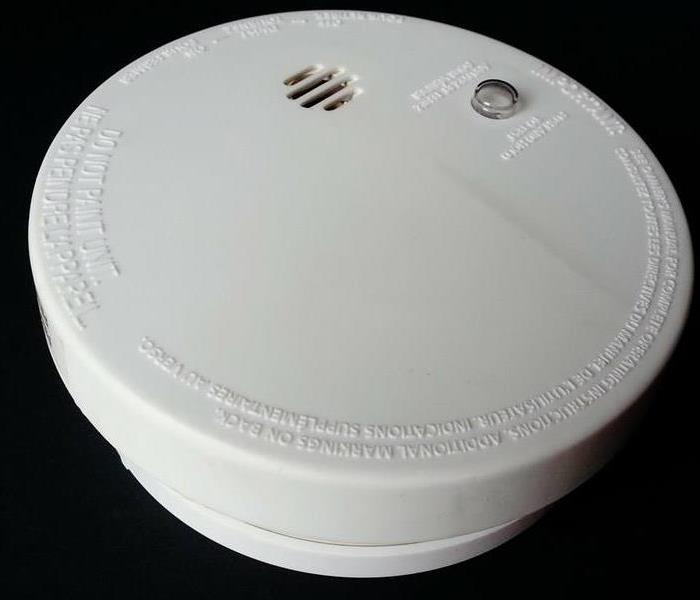 What a smoke alarm looks like.
What a smoke alarm looks like.
When it comes to your family's safety, smoke detectors and fire alarms can be some of the most important items in your home. These early warning devices can alert your family to fire and hazardous smoke while there is still time to evacuate, but they should be tested periodically to ensure they are working properly.
Electronic devices are not faultless. The batteries will die and other parts of the smoke alarm can wear out over time. Regularly testing them and replacing the batteries (or the entire device) can help keep your family safe in the event of a house fire.
Be sure to read your smoke detector's owner's manual - you may need to check more often if any of the following apply: The detector often gives false alarms.
The alarm emits short beeps regularly without anyone touching it.
Frequent kitchen fumes often activate it, which can cause it to wear out faster.
For battery operated: This type may be prone to defective or worn out batteries. Monthly tests are very important.
Never put old batteries in your smoke detectors and fire detectors. Wired: These detectors are powered by your home's electrical system, but they usually have backup batteries so the device stays operational in the event of a power outage.
Wired smoke alarms should still be tested monthly to ensure both batteries and components are working properly.
You should always check manufacturer's instructions for the correct test method for your smoke detector and fire alarm.
You may want to install additional detectors in areas where the alarm sound is low, muffled or weak. Press and hold the test button on the smoke detector. It may take a few seconds to go off, but a loud, deafening siren should come out of the smoke detector when the button is pressed. If not, then replace it.
If it has been more than six months since you last changed the batteries (whether your detector is battery powered or wired), replace it now and test the new batteries one last time to ensure they are working properly, regardless of the test result. .
You should also look at your smoke alarm to make sure it's not dust or any other substance blocking the grilles and causing it to not work even if the batteries are new. Note that smoke detectors typically have a 10-year lifespan.
Now that you know how to prevent your fire alarms from not working, do keep in mind that if they are not working correctly this can cause a house fire. We don't want this to happen at all, but if it does SERVPRO is here to help! We do fire damage remediation at it's best.
What Exactly is Fire Damage?
7/1/2022 (Permalink)
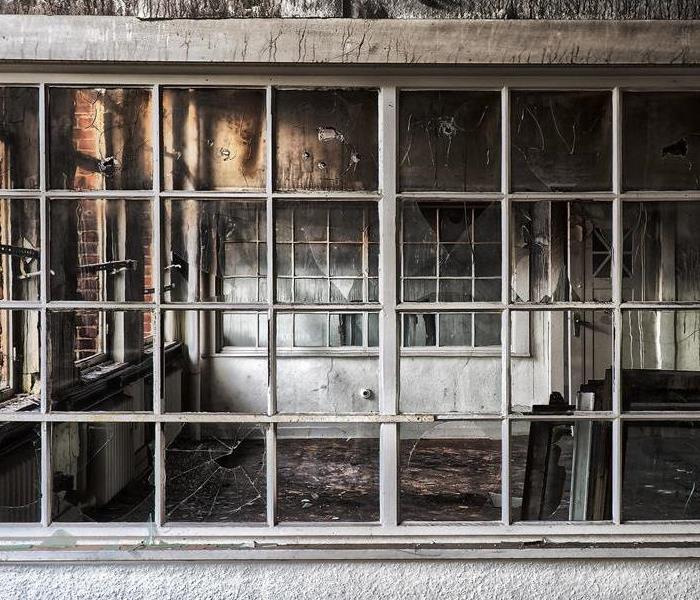 What remains after a house fire.
What remains after a house fire.
What is fire damage?
A fire in your home can cause devastating damage and require you to act quickly to save as much of your valuable property as possible. There is also the possibility that your house may go up in flames, causing the surrounding area to be filled with smoke and fumes that can eventually be toxic. This article will outline what you should know about fire and the safety precautions you should take if home fires are to occur.
Why is Fire Risk in Your Home at High?
The factors that determine whether a home will be harmed by fire are many. However, those that appear to be most important are the air and heat in the rooms and the walls, combustible material in the home, a poorly constructed home, and age or damage at the attic level. The National Fire Protection Association, or NFFP, recommends to families that they avoid using open flames in all forms at any time, particularly in any heating system.
There are, however, times when open flames are needed or required for cooking and some other activities. This may come about from using open fires in the fireplace for heat or smoke, or due to open flames in a stove or a clothes washer. Also, if your kitchen is very small, then it may be worth giving consideration to using electric space heaters on the countertops rather than open flames. Another risk to consider is the use of open flames in a gas grill. While a gas grill can operate on a pilot flame and is considered safe in most instances, there is always the possibility that there may be an open flame in the grilling area of a gas grill.
The cost of fire damage.
A great number of fire incidents occur in the home. Many homeowners do not have any insurance on their home, or they have it for only a single year, but a couple of times they have insurance for the whole of their life. This is very important as you have to consider fire damage insurance in your life to save your house from financial ruin.
The most important thing is that you should not ignore fire and gas damage when they are occurring. In most cases, the insurance company will provide a minimum of coverage for fire and gas, but it does not mean it will cover fire damage completely. This is due to the fact that damage is subjective. It is not limited to how many homes a fire or gas strike has destroyed. Even if your home has been completely burnt down by fire, you still have to assess the damage. The best thing is, there are many fire damage insurance companies in the market today willing to pay for your claim, you just have to find the best deal possible.
The first thing to do is assess and inspect which areas are affected by the fire. This part is not so difficult, since you cannot see the extent of the fire damage.
Step 2: Check the property damage claim. Some insurance companies will not cover any damage to the inside of the house, but do offer any property damage claims to the exterior of the house. If there is any damage to any areas that are not covered from all parties, the insurance company will be very helpful in calculating the damage, and will get you the necessary compensation.
Step 3: Request a claim form from the insurance company. Many insurance companies make a claim form available to the homeowner. As you know, there will be a number of claims sent for the homeowner, there will also be a claim number corresponding to the claim number given by the insurance company
If you find yourself with fire damage. Please call SERVPRO. We can help!
Dryers and Fires.
6/15/2021 (Permalink)
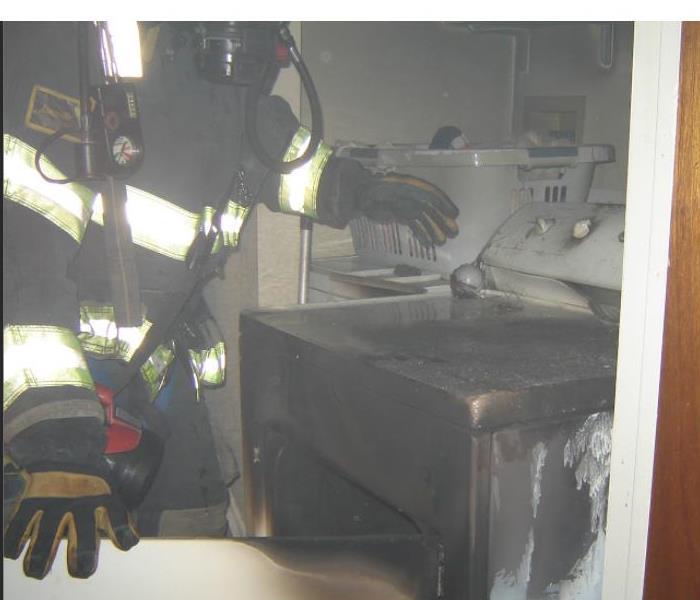 The dryer has caught on fire and been put out. Leaving it fire and smoke damage.
The dryer has caught on fire and been put out. Leaving it fire and smoke damage.
Why dryers catch on fire.
My clothes still need doing, and I still find time in even my busiest day to do so. But it is at these moments that we sometimes forget about the dryers.
Not because it is so often at just such a time but because the dryers are so dangerous. That is why it is important to keep up with tips and strategies to prevent dryer fires. To that end, we have to remember that dryers are like appliances that are set to work as part of the daily laundry cycle and thus use a few small parts to ignite.
Here are a couple of things to remember:
Why you don't leave the dryer going when no one is home.
Why you don't leave the dryer going when no one is home.
A big reason to prevent dryer fires is that the fire often leads to a second or third fire or can be a safety hazard. It's always better to prevent fire than to respond to a fire situation.
Before dryer fires occur, we usually have a fire hazard situation. If you have a hot water pipe in your kitchen and fire could start there, use a fire extinguisher. A fire extinguisher can be used effectively to save your property from dryer fires. A fire extinguisher can also be used effectively to extinguish and prevent a fire from occurring at a dryer.
How to clean the dryer lint.
The heat from the dryer is always intense. The machine uses large heat capacity to absorb the heat, leaving the dryer lint sitting on top of the inside of the machine after every cycle. You'll notice that the top of the dryer is always smeared with dryer lint and what is left over after the dryer door closes. The lint can cause a fire. How to minimize this risk?
Simply make sure you throw away the lint from the lint filter after every use.
But if this does happen and you end up with fire damage. Please call SERVPRO. We can help.
How to prevent your grill from catching on fire and burning down your house.
6/3/2021 (Permalink)
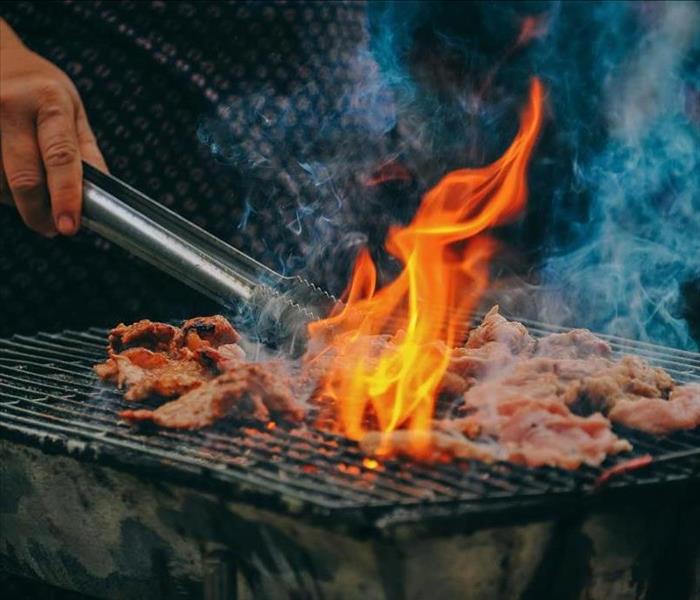 A man grilling out with a fire flare up happening.
A man grilling out with a fire flare up happening.
We all know that Holidays revolve around family, food, and friends. So this father's day, we are sure there are going to be some grills fired up. It is good though to be safe and keep in mind that there are some best practices we want to share with you.
HOW TO PREVENT FLARE-UPS
Trim the fat.
Flare-ups usually happen because of excess fat, sauces or oily marinades. So trim as much excess fat as you can, without sacrificing flavor.
Keep the lid open.
When searing fatty foods, leave the grill lid opened.
Avoid wind.
Try to keep your grill away from windy areas. Wind forces oxygen between the grates, which can fuel a flare-up.
Move your food.
Try not to overcrowd your food on your grill. If a flare-up does happen, you want to be able to move your food away from the flame.
Burn the grease away.
During cooking, if grease pools, remove your food and turn the burners on high with the grill lid open until grease has burned off.
Clean your grill.
Keeping your grill clean and maintained will help prevent the dreaded flare-up. Food residue and old grease are both great fuel for a fire, so removing debris after each use is important.
Turn off the burners.
If your grill flare-up is out-of-control, turn off the burners.
Don't use water.
You’ve heard the adage, “Oil and water don’t mix?” Well that’s especially true for flare-ups. Spraying water on a flare-up can cause grease to explode. Don’t use it.
However, we know accidents happen. That is why SERVPRO is here. To help you if your grill or anything else was to catch your home on fire.
Are your fire alarms up to par? SERVPRO can help.
6/3/2021 (Permalink)
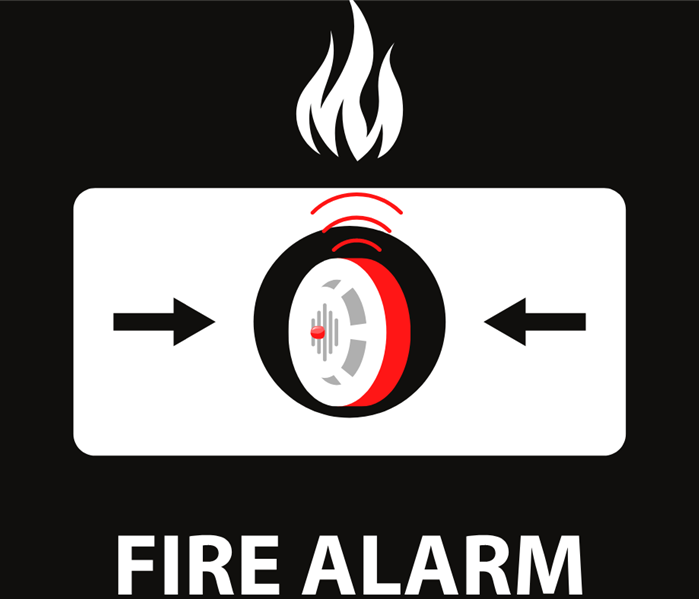 Illustration of a working fire alarm.
Illustration of a working fire alarm.
When it comes to your family's safety, smoke detectors and fire alarms can be some of the most important items in your home. These early warning devices can alert your family to fire and hazardous smoke while there is still time to evacuate, but they should be tested periodically to ensure they are working properly.
Electronic devices are not faultless. The batteries will die and other parts of the smoke alarm can wear out over time. Regularly testing them and replacing the batteries (or the entire device) can help keep your family safe in the event of a house fire.
According to the U. S. Fire Administration (USFA), smoke detectors should be tested at least once a month and batteries should be replaced at least twice a year. A good way to remember this is to replace your batteries when replacing your watches.
Be sure to read your smoke detector's owner's manual - you may need to check more often if any of the following apply: The detector often gives false alarms.
The alarm emits short beeps regularly without anyone touching it.
Frequent kitchen fumes often activate it, which can cause it to wear out faster.
For battery operated: This type may be prone to defective or worn out batteries. Monthly tests are very important.
Never put old batteries in your smoke detectors and fire detectors. Wired: These detectors are powered by your home's electrical system, but they usually have backup batteries so the device stays operational in the event of a power outage.
Wired smoke alarms should still be tested monthly to ensure both batteries and components are working properly.
You should always check manufacturer's instructions for the correct test method for your smoke detector and fire alarm.
Smoke detectors have a loud alarm that can frighten small children, so you want to let everyone know that you plan to test the alarms so as not to scare anyone.
You may want to install additional detectors in areas where the alarm sound is low, muffled or weak. Press and hold the test button on the smoke detector. It may take a few seconds to go off, but a loud, deafening siren should come out of the smoke detector when the button is pressed. If not, then replace it.
If it has been more than six months since you last changed the batteries (whether your detector is battery powered or wired), replace it now and test the new batteries one last time to ensure they are working properly, regardless of the test result. .
You should also look at your smoke alarm to make sure it's not dust or any other substance blocking the grilles and causing it to not work even if the batteries are new. Note that smoke detectors typically have a 10-year lifespan.
Now that you know how to prevent your fire alarms from not working, do keep in mind that if they are not working correctly this can cause a house fire. We don't want this to happen at all, but if it does SERVPRO is here to help! We do fire damage remediation at it's best.
Understanding Fire Damage.
6/3/2021 (Permalink)
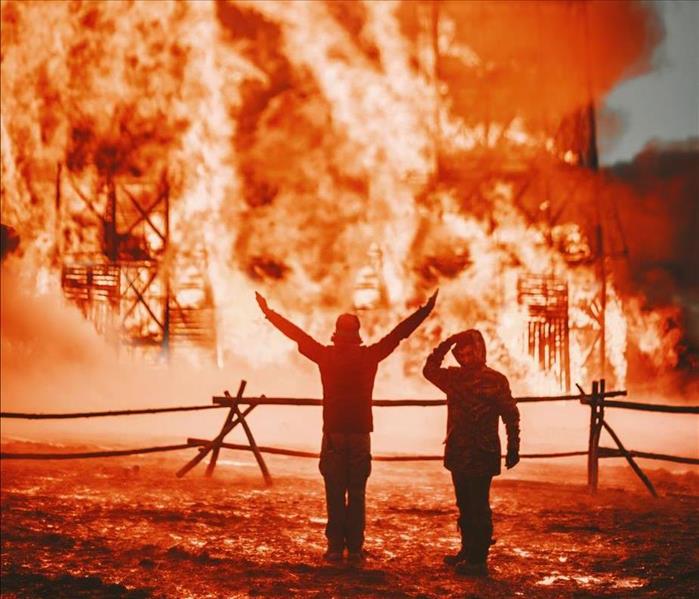 Two people watching house burn down from fire.
Two people watching house burn down from fire.
What is fire damage?
A fire in your home can cause devastating damage and require you to act quickly to save as much of your valuable property as possible. There is also the possibility that your house may go up in flames, causing the surrounding area to be filled with smoke and fumes that can eventually be toxic. This article will outline what you should know about fire and the safety precautions you should take if home fires are to occur.
Why is Fire Risk in Your Home at High?
The factors that determine whether a home will be harmed by fire are many. However, those that appear to be most important are the air and heat in the rooms and the walls, combustible material in the home, a poorly constructed home, and age or damage at the attic level. The National Fire Protection Association, or NFFP, recommends to families that they avoid using open flames in all forms at any time, particularly in any heating system.
There are, however, times when open flames are needed or required for cooking and some other activities. This may come about from using open fires in the fireplace for heat or smoke, or due to open flames in a stove or a clothes washer. Also, if your kitchen is very small, then it may be worth giving consideration to using electric space heaters on the countertops rather than open flames. Another risk to consider is the use of open flames in a gas grill. While a gas grill can operate on a pilot flame and is considered safe in most instances, there is always the possibility that there may be an open flame in the grilling area of a gas grill.
Do I need to protect a home from fire damage.
If you don't know how to apply fire retardants, you can start here.
Fire damage is arguably the most serious type of disaster that we could be faced with and the only one that could threaten our comfort.
Do We Need To Fireproof Our Home?
Fire damage is common for all homes even small homes. But, in the event that we don’t have insurance to cover a fire, it’s essential that we should have a plan in place that will allow us to prevent damage from occurring to the structure. Even if you don’t expect to need an insurance claim, many homeowners are advised to put a plan in place prior to an impending fire for future fire protection needs.
Before a home burns down, it’s important to do the preparation work that will protect the home from fire damage.
Keep your home’s rooms well lit when you go out and prepare for fire damage.
Avoid leaving electrical appliances in the open and instead install a timer that will turn them off after a certain period of time.
The cost of fire damage.
A great number of fire incidents occur in the home. Many homeowners do not have any insurance on their home, or they have it for only a single year, but a couple of times they have insurance for the whole of their life. This is very important as you have to consider fire damage insurance in your life to save your house from financial ruin.
The most important thing is that you should not ignore fire and gas damage when they are occurring. In most cases, the insurance company will provide a minimum of coverage for fire and gas, but it does not mean it will cover fire damage completely. This is due to the fact that damage is subjective. It is not limited to how many homes a fire or gas strike has destroyed. Even if your home has been completely burnt down by fire, you still have to assess the damage. The best thing is, there are many fire damage insurance companies in the market today willing to pay for your claim, you just have to find the best deal possible.
The first thing to do is assess and inspect which areas are affected by the fire. This part is not so difficult, since you cannot see the extent of the fire damage.
Step 2: Check the property damage claim. Some insurance companies will not cover any damage to the inside of the house, but do offer any property damage claims to the exterior of the house. If there is any damage to any areas that are not covered from all parties, the insurance company will be very helpful in calculating the damage, and will get you the necessary compensation.
Step 3: Request a claim form from the insurance company. Many insurance companies make a claim form available to the homeowner. As you know, there will be a number of claims sent for the homeowner, there will also be a claim number corresponding to the claim number given by the insurance company
10 Reasons for Household Fires.
5/26/2021 (Permalink)
 The house has caught on fire and is burning.
The house has caught on fire and is burning.
Below are some of the most common causes of house fires, and some tips to take precautions.
1. Cooking
Pots and pans can overheat and cause a fire very easily if the person cooking gets distracted and leaves cooking unattended. Always stay in the room, or ask someone to watch your food, when cooking on hotplates.
2. Heating
Keep portable heaters at least one meter away from anything that could easily catch fire such as furniture, curtains, laundry, clothes and even yourself. If you have a furnace, get it inspected once a year to make sure it is working to safety standards.
3. Smoking
Bedrooms are best to be kept off limits for smoking. A cigarette that is not put out properly can cause a flame, as the butt may stay alit for a few hours. It could burst into flames if it came into contact with flammable materials, such as furniture. Did you know that fires started in the bedroom or lounge make up 73% of all house fire fatalities?¹
4. Electrical Equipment
An electrical appliance, such as a toaster can start a fire if it is faulty or has a frayed cord. A power point that is overloaded with double adapter plugs can cause a fire from an overuse of electricity. A power point extension cord can also be a fire hazard if not used appropriately. Double check the appliances and power points in your home.
5. Candles
Candles look and smell pretty, but if left unattended they can cause a room to easily burst into flames. Keep candles away from any obviously flammable items such as books and tissue boxes. Always blow a candle out before leaving a room. Did you know that in Perth last year 34 house fires started as a result of candles?²
6. Curious Children
Kids can cause a fire out of curiosity, to see what would happen if they set fire to an object. Keep any matches or lighters out of reach of children, to avoid any curiosity turned disaster. Install a smoke alarm in your child’s room and practice a home escape plan with your children and family in case there was a fire. Teach kids understand the ” drill as well as the "stop, drop, cover and roll" knowing their address if they needed to call 000.
7. Faulty Wiring
Homes with inadequate wiring can cause fires from electrical hazards. Some signs to see if you’ve bad wiring are: 1) Lights dim if you use another appliance; 2) For an appliance to work, you have to disconnect another; 3) Fuses blow or trip the circuit frequently. Have a licensed electrician come and inspect you house, or contact your landlord if you have any of the above occurrences.
8. Barbeques
Barbeques are great for an outdoor meal, but should always be used away from the home, tablecloths or any plants and tree branches. Keep BBQs regularly maintained and cleaned with soapy water and clean any removable parts. Check the gas bottle for any leaks before you use it each time.
9. Flammable Liquids
If you have any flammable liquids in the home or garage such as petrol, kerosene or methylated spirits, keep them away from heat sources and check the label before storing. Be careful when pouring these liquids.
10. Lighting
Lamp shades and light fittings can build up heat if they are very close to light globes. Check around the house to make sure. Lamp bases can become a hazard if they are able to be knocked over easily, and so should be removed if they are. Check that down lights are insulated from wood paneling or ceiling timbers.
The above tips are a good guide to avoiding a fire in your home. However it’s a good idea to protect yourself with adequate home and content insurance, cover to ensure you are covered in the unlikely event a fire were to happen.
Source: https://www.realinsurance.com.au/news-views/the-most-common-causes-of-house-fires
Testing Your Fire Alarm
10/10/2019 (Permalink)
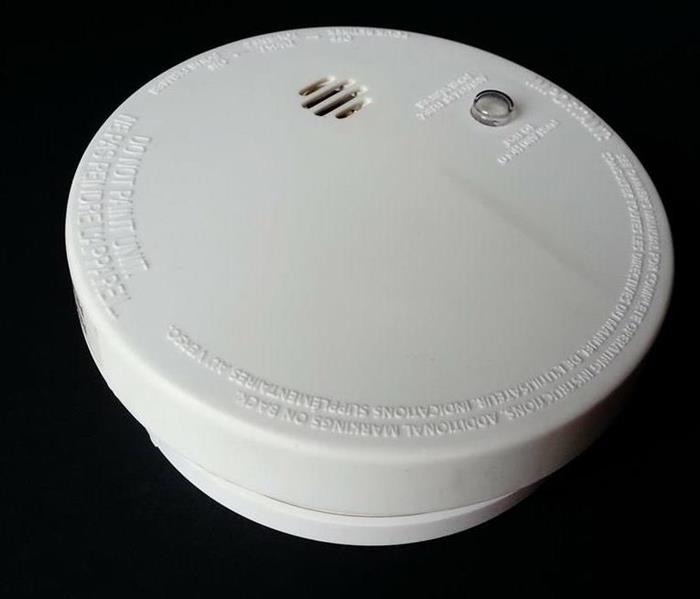 Family's smoke alarm in place in their home.
Family's smoke alarm in place in their home.
Smoke detectors and fire alarms may be some of the most important items in your home when it comes to your family’s safety. These early warning devices may help alert your family to fire and dangerous smoke while there is still time to evacuate, but they need to be periodically tested to help ensure proper function.
Why Do It?
Electronic devices are not infallible. Batteries die, and other parts of the smoke detector can wear out over time. Testing them regularly and replacing batteries (or the entire device) is one way to help ensure your family stays safe should there be a fire in your home.
How Often?
According to the U.S. Fire Administration (USFA), smoke detectors should be tested at least once a month and batteries should be replaced at least twice a year. A good way to help remember to do this is to change your batteries when you change your clocks for daylight saving time — when you spring forward or fall back. Make sure to review your smoke detector’s user manual — you may need to check more often if any of the following apply:
- The detector often gives false alarms.
- The alarm emits short beeps regularly without anyone touching it.
- Frequent kitchen smoke has caused it to activate often, which may wear it out faster.
There are two main types of smoke detectors, according to the USFA:
Battery-powered: This type can be susceptible to defective or worn-out batteries. Monthly testing is critical. Never put old batteries into your smoke detectors and fire alarms.
Hardwired: These detectors are powered by your home electrical system, but they usually have back-up batteries so the device can remain operational in a power outage. Hardwired smoke detectors still require monthly testing to help ensure that both batteries and parts are functioning properly.
How to Test It
You should always check the manufacturer’s instructions for the proper method of testing your smoke detector and fire alarm. But, in general, most battery-powered and hardwired smoke detectors can be tested in the following way:
Step 1. Alert family members that you will be testing the alarm. Smoke detectors have a high-pitched alarm that may frighten small children, so you’ll want to let everyone know you plan to test the alarms to help avoid frightening anyone.
Step 2. Station a family member at the furthest point away from the alarm in your home. This can be critical to help make sure the alarm can be heard everywhere in your home. You may want to install extra detectors in areas where the alarm’s sound is low, muffled or weak.
Step 3. Press and hold the test button on the smoke detector. It can take a few seconds to begin, but a loud, ear-piercing siren should emanate from the smoke detector while the button is pressed. If the sound is weak or nonexistent, replace your batteries. If it has been more than six months since you last replaced the batteries (whether your detector is battery-powered or hardwired), change them now regardless of the test result, and test the new batteries one final time to help ensure proper functioning. You should also look at your smoke detector to make sure there’s no dust or other substance blocking its grates, which may prevent it from working even if the batteries are new.
Remember, smoke detectors have a normal life span of 10 years, according to the USFA. Even if you’ve performed regular maintenance, and your device is still functional, you should replace a smoke detector after the 10-year period or earlier, depending on the manufacturer’s instructions.
Installing smoke detectors can be a great way to help keep your family safe, but assuming they are working may lead to a dangerous situation. Taking a few minutes to check them regularly can help ensure they’re working properly.
Source: https://blog.allstate.com/test-smoke-detectors/
Testing Your Fire Alarm
9/27/2019 (Permalink)
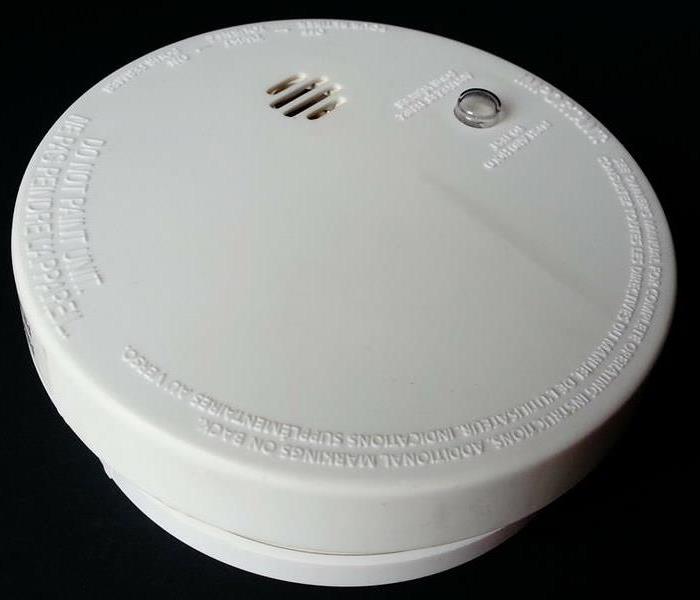 Smoke detector for home.
Smoke detector for home.
Smoke detectors and fire alarms may be some of the most important items in your home when it comes to your family’s safety. These early warning devices may help alert your family to fire and dangerous smoke while there is still time to evacuate, but they need to be periodically tested to help ensure proper function.
Why Do It?
Electronic devices are not infallible. Batteries die, and other parts of the smoke detector can wear out over time. Testing them regularly and replacing batteries (or the entire device) is one way to help ensure your family stays safe should there be a fire in your home.
How Often?
According to the U.S. Fire Administration (USFA), smoke detectors should be tested at least once a month and batteries should be replaced at least twice a year. A good way to help remember to do this is to change your batteries when you change your clocks for daylight saving time — when you spring forward or fall back. Make sure to review your smoke detector’s user manual — you may need to check more often if any of the following apply:
- The detector often gives false alarms.
- The alarm emits short beeps regularly without anyone touching it.
- Frequent kitchen smoke has caused it to activate often, which may wear it out faster.
There are two main types of smoke detectors, according to the USFA:
Battery-powered: This type can be susceptible to defective or worn-out batteries. Monthly testing is critical. Never put old batteries into your smoke detectors and fire alarms.
Hardwired: These detectors are powered by your home electrical system, but they usually have back-up batteries so the device can remain operational in a power outage. Hardwired smoke detectors still require monthly testing to help ensure that both batteries and parts are functioning properly.
How to Test It
You should always check the manufacturer’s instructions for the proper method of testing your smoke detector and fire alarm. But, in general, most battery-powered and hardwired smoke detectors can be tested in the following way:
Step 1. Alert family members that you will be testing the alarm. Smoke detectors have a high-pitched alarm that may frighten small children, so you’ll want to let everyone know you plan to test the alarms to help avoid frightening anyone.
Step 2. Station a family member at the furthest point away from the alarm in your home. This can be critical to help make sure the alarm can be heard everywhere in your home. You may want to install extra detectors in areas where the alarm’s sound is low, muffled or weak.
Step 3. Press and hold the test button on the smoke detector. It can take a few seconds to begin, but a loud, ear-piercing siren should emanate from the smoke detector while the button is pressed. If the sound is weak or nonexistent, replace your batteries. If it has been more than six months since you last replaced the batteries (whether your detector is battery-powered or hardwired), change them now regardless of the test result, and test the new batteries one final time to help ensure proper functioning. You should also look at your smoke detector to make sure there’s no dust or other substance blocking its grates, which may prevent it from working even if the batteries are new.
Remember, smoke detectors have a normal life span of 10 years, according to the USFA. Even if you’ve performed regular maintenance, and your device is still functional, you should replace a smoke detector after the 10-year period or earlier, depending on the manufacturer’s instructions.
Installing smoke detectors can be a great way to help keep your family safe, but assuming they are working may lead to a dangerous situation. Taking a few minutes to check them regularly can help ensure they’re working properly.
Source: https://blog.allstate.com/test-smoke-detectors/
Damage From Restaurant Kitchen Fire
9/25/2019 (Permalink)
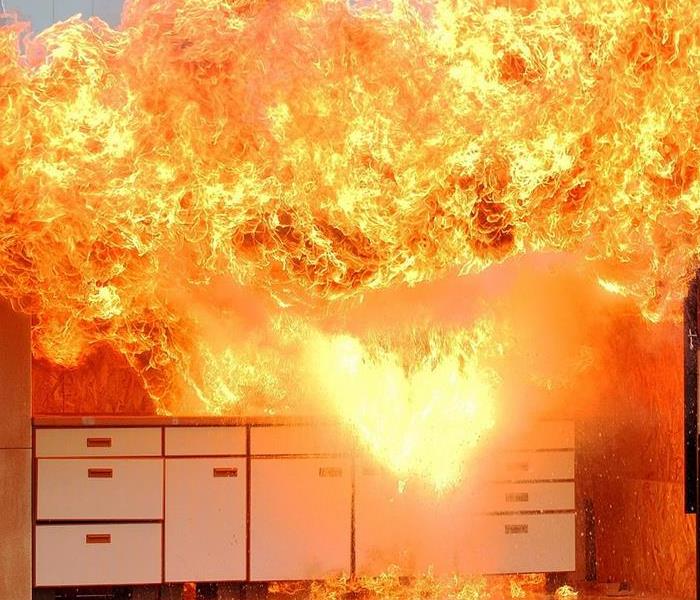 Restaurant kitchen counters on fire
Restaurant kitchen counters on fire
A restaurant kitchen fire can be devastating and dangerous, no doubt. As we all know, a restaurant is only able to operate with a working kitchen. Depending on the severity of the kitchen fire, the doors of the restaurant may have to close for a period of time while the restoration process takes place. This is never good for the business owners or for the public who enjoy the tasty food!
After the restoration team arrives and begins their process, detailed information will be noted about the damage of the fire itself. For example, they may note structural damage, interior damage to seating areas, damage to the kitchen equipment itself, sprinkler systems, etc.
This kind of fire damage requires extensive cleaning to handle soot, ash, and removing smoke odor from the restaurant. In some situations, special chemicals may have to be used for counters, kitchen ranges and exhaust hoods, walls and ceilings, doors, and other appliances, as soot and smoke often create toxic fumes that are hazardous to breathe in.
Smoke odor may not be fully removable in some of the worst cases, and that will mean surfaces have to be deep cleaned and then repainted and or resealed to eliminate the issue altogether.
After the smoke odor and soot remains are gone, it's time to replace the damaged kitchen equipment. The restaurant owner may have to purchase a new stove, oven, warming container, or just about anything between. This can be costly, but if good insurance is in place, the owner can start this part of the re-opening process with confidence.
Any kind of fire is devastating and scary - restaurant kitchen fires are not exempt. If you face fire damage in your restaurant's kitchen, rest assured that our team of fire damage experts is on the way to get the restoration process started. Don't hesitate to give us a call when you need us.
Sources of Fire Damage
9/4/2019 (Permalink)
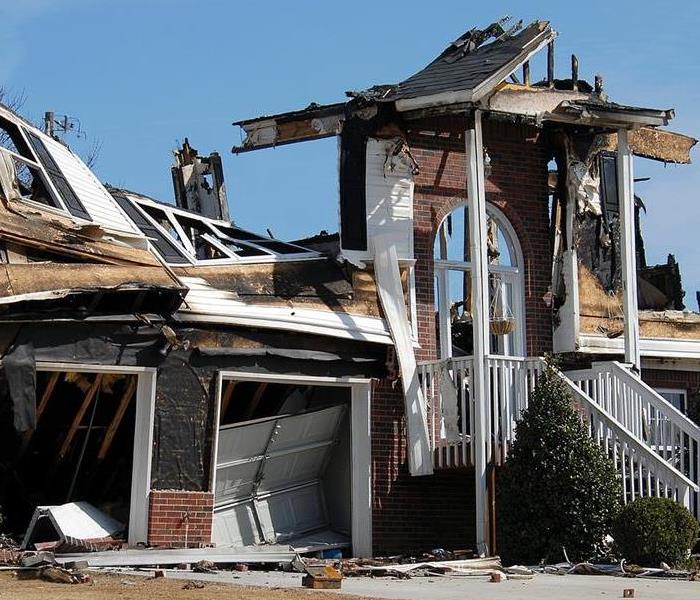 Fire damage to a local home.
Fire damage to a local home.
You probably have heard lectures and read countless brochures and handbooks regarding fire safety. Fire safety is a very important topic that shouldn’t be taken lightly. You may not realize how often you come into contact with a situation that could result in a damaging fire. Some of those situations are recreational with friends and family and some of them are in your own home while cooking dinner. Let’s discuss some of the most common sources of fires.
Campfires and firepits. Summers usually involve campfires, bonfires, and firepits depending on where you live. It’s fun to have friends and family over for a cookout and s’mores or coffee by the fire. However, it’s essential that you practice fire safety techniques when lightning any kind of fire.
Moreover, if you are lighting a campfire or bonfire, plan to have adequate water on hand to put it out when you’re ready to leave. Never start a fire when you don’t have access to water.
Be sure that no one is getting too close to the fire, horse-playing, getting intoxicated, and be sure that kids stay away from the flames. There should never be brush, leaves, other trees, buildings, or vehicles nearby when having an outdoor fire. Wind can easily carry sparks and ignite surrounding items causing even more damage and harm to your guests.
If you’re using a firepit, be sure to have water on hand to put the fire out. Also, utilize the cap or top/cover that came with your pit to help contain sparks and ash from spreading around your yard and potentially causing a secondary fire.
Fireworks. Fireworks can be a ton of fun! Especially in the summertime. However, with typically dryer conditions, secondary fires can easily be lit causing damage to homes and vehicles.
If you use fireworks, be sure to have a water source to eliminate the flames after the combustion takes place. Also, be vigilant in making sure that no other sparks or flames ignite after landing. Never shoot fireworks near a home, building, vehicle, or trees.
Electrical. If you have electrical cords running to equipment in your yard or free-standing garage, make sure they are in great shape, insulated properly, and that there is no overloading of electric sources.
Also, be sure that your stove, washer and dryer, etc. are wired correctly and are approved by a licensed electrician to avoid house fires.
Our team is here to help when disaster strikes! Fire is a beautiful thing but can be a devastating thing when it consumes or damages your belongings. If you come face to face with fire damage, call us. We will be there quick to get you the help you need in the restoration process.
6 Things You Need To Do After a House Fire
4/2/2018 (Permalink)
 6 Things You Need To Do After a House Fire
6 Things You Need To Do After a House Fire
You may think a house fire will never happen to you. But what if it does? Are you prepared?
Figuring out what to do after a home fire can be a very stressful and overwhelming process, and it can be hard to decide what to do first. With a little help from your insurance agent, though, you may be able to settle your claim more quickly and get your life back to normal.
Here are the six things you should do after a home fire.
1. Call your insurance agent immediately. You will be getting calls at all hours of the day from public adjusters and contractors who will try to offer you a deal on putting your house back together. These calls can create a lot of stress and confusion. I suggest you speak to no one but your agent to discuss your options at this point in the process.
2. Ask about restoration companies that can help with cleaning up soot, boarding up windows, and other construction. Immediately after a fire, especially if it is a minor one, you’ll need to clean up any soot or water damage. It is important to hire a reputable service to deal with these issues. Ask your agent or insurance adjuster to recommend a few different companies. They deal with these situations more often than you do and likely know of some businesses that fit your needs. Many of these restoration companies have connections to good contractors, engineers, and architects, as well.
3. Separate damaged property from undamaged property. The insurance company will need a detailed inventory list from you after they inspect the loss. Separating your damaged property from your undamaged property will make it easier for you to make a list of your damaged items. This list needs to include the date you purchased each item, the brand name, the price you paid, and the serial number, model, or description of each item. If the item was a gift, be sure to indicate that as well.
It’s a good idea to submit your receipts with this inventory list. If the receipts were destroyed in the fire, or you didn’t keep any receipts, request copies of prior bank statements. This can make obtaining duplicate receipts easier. Keep in mind that photos of any damaged items are always helpful if receipts are not available.
4. Save undamaged property from further destruction. Any items that are not damaged should be put in a safe place, even if it means putting them in storage. Insurance adjusters are typically fair when it comes to adding additional costs for storage.
5. Cooperate fully with the insurance company’s investigation. When a fire claim is reported to an insurance company, it is given top priority. Usually the adjusters come out to see the loss within 24 to 48 hours. To help settle your claim in a timely manner and to your satisfaction, be sure you are available and on time for all meetings, that you return calls promptly, that any requested paperwork is completed as quickly as possible, and that you contact the company or your agent immediately with any questions.
6. Find somewhere to stay if you can’t live in your home. Most homeowner’s policies include “Loss of Use or Loss of Rents” coverage, which will pay for the food, clothing, and shelter that you and your family may need for a specified period of time. Keep in mind that your policy will pay for “like kind and quality” living arrangements. You may want to save the Ritz for a special occasion and instead stay in a more reasonably priced hotel.
What to do before disaster strikes
• Review your homeowner’s policy to be sure you have replacement cost coverage, loss of use coverage, and adequate dwelling coverage. The last thing you want to hear after a fire is that you were underinsured.
• Save all your receipts and put them in a metal fireproof box or in a storage facility off the premises, such as a safety deposit box. Better yet, scan the receipts and save them to a computer file. Taking a video of your entire home and the possessions within it is the next best thing to receipts. This will show the insurance company what sort of lifestyle you had prior to the claim.
• Be sure to have smoke detectors in every room of your home to ensure that everyone gets out of the house or apartment safely in the event of a fire. Have exit ladders and fire extinguishers handy, and know how to use them.
• Discuss escape strategies and plans with your family prior to a fire, and consider a fire drill to help ensure everyone’s safety.
Written by Heidi Petschauer
Source: https://blog.equifax.com/credit/six-things-you-need-to-do-after-a-house-fire/
How To Test Your Fire Alarm
3/12/2018 (Permalink)
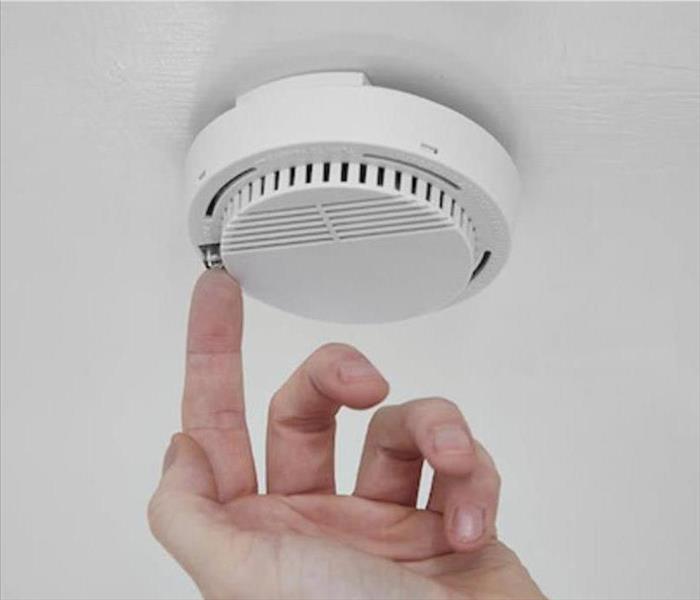 How To Test Your Fire Alarm
How To Test Your Fire Alarm
Smoke detectors and fire alarms may be some of the most important items in your home when it comes to your family’s safety. These early warning devices may help alert your family to fire and dangerous smoke while there is still time to evacuate, but they need to be periodically tested to help ensure proper function.
Why Do It?
Electronic devices are not infallible. Batteries die, and other parts of the smoke detector can wear out over time. Testing them regularly and replacing batteries (or the entire device) is one way to help ensure your family stays safe should there be a fire in your home.
How Often?
According to the U.S. Fire Administration (USFA), smoke detectors should be tested at least once a month and batteries should be replaced at least twice a year. A good way to help remember to do this is to change your batteries when you change your clocks for daylight saving time — when you spring forward or fall back. Make sure to review your smoke detector’s user manual — you may need to check more often if any of the following apply:
- The detector often gives false alarms.
- The alarm emits short beeps regularly without anyone touching it.
- Frequent kitchen smoke has caused it to activate often, which may wear it out faster.
There are two main types of smoke detectors, according to the USFA:
Battery-powered: This type can be susceptible to defective or worn-out batteries. Monthly testing is critical. Never put old batteries into your smoke detectors and fire alarms.
Hardwired: These detectors are powered by your home electrical system, but they usually have back-up batteries so the device can remain operational in a power outage. Hardwired smoke detectors still require monthly testing to help ensure that both batteries and parts are functioning properly.
How to Test It
You should always check the manufacturer’s instructions for the proper method of testing your smoke detector and fire alarm. But, in general, most battery-powered and hardwired smoke detectors can be tested in the following way:
Step 1. Alert family members that you will be testing the alarm. Smoke detectors have a high-pitched alarm that may frighten small children, so you’ll want to let everyone know you plan to test the alarms to help avoid frightening anyone.
Step 2. Station a family member at the furthest point away from the alarm in your home. This can be critical to help make sure the alarm can be heard everywhere in your home. You may want to install extra detectors in areas where the alarm’s sound is low, muffled or weak.
Step 3. Press and hold the test button on the smoke detector. It can take a few seconds to begin, but a loud, ear-piercing siren should emanate from the smoke detector while the button is pressed. If the sound is weak or nonexistent, replace your batteries. If it has been more than six months since you last replaced the batteries (whether your detector is battery-powered or hardwired), change them now regardless of the test result, and test the new batteries one final time to help ensure proper functioning. You should also look at your smoke detector to make sure there’s no dust or other substance blocking its grates, which may prevent it from working even if the batteries are new.
Remember, smoke detectors have a normal life span of 10 years, according to the USFA. Even if you’ve performed regular maintenance, and your device is still functional, you should replace a smoke detector after the 10-year period or earlier, depending on the manufacturer’s instructions.
Installing smoke detectors can be a great way to help keep your family safe, but assuming they are working may lead to a dangerous situation. Taking a few minutes to check them regularly can help ensure they’re working properly.
Source: https://blog.allstate.com/test-smoke-detectors/
Fire Safety Tips
12/18/2017 (Permalink)
 Fire Safety
Fire Safety
Tips For Fire Safety:
Install smoke alarms on every level of your home, inside bedrooms and outside sleeping areas.
Test smoke alarms every month. If they’re not working, change the batteries.
Talk with all family members about a fire escape plan and practice the plan twice a year.
If a fire occurs in your home, GET OUT, STAY OUT and CALL FOR HELP. Never go back inside for anything or anyone.
We partner with the American Red Cross and also our local fire departments so fire prevention is VERY important to us! These tips are from REDCROSS.ORG
Here are some tips on WHAT TO DO AFTER A FIRE:
Call 9-1-1. Give first aid where needed; cool and cover burns to reduce the chance of further injury or infection.
Let friends and family know you’re safe.
People and animals that are seriously injured or burned should be transported to professional medical or veterinary help immediately.
Stay out of fire-damaged homes until local fire authorities say it is safe to re-enter.
Caring for Yourself & Loved Ones
- Pay attention to how you and your loved ones are experiencing and handling stress. Promote emotional recovery by following these tips. Discard any food that has been exposed to heat, smoke or soot.
- Watch pets closely and keep them under your direct control.
- Help people who require additional assistance- infants, elderly people, those without transportation, large families who may need additional help in an emergency situation, people with disabilities, and the people who care for them.
Also from REDCROSS.ORG, check it out for more information and make sure you are prepared in case an emergency happens in your Tennessee home!
Source: http://www.SERVPRObirminghamsouth.com/blog/post/32231/fire-smoke-damage-restoration/fire-safety-tips
The Most Common Causes of House Fires
11/6/2017 (Permalink)
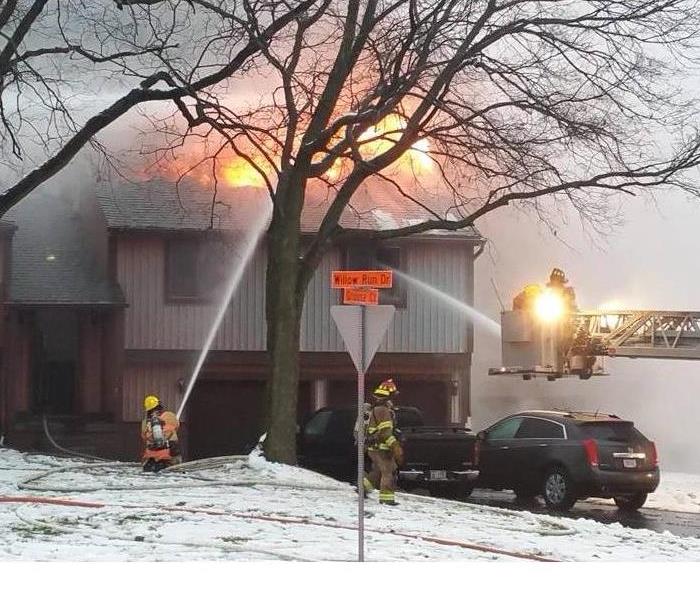 Winter house fire
Winter house fire
A house can easily catch fire from the misuse of appliances and heating equipment to smoking in bedrooms. In Australia’s hot summer months, temperatures can soar past 40°C and teamed with a dry climate, conditions are ideal for fires to break out.
However you can take measures to avoid fire in home and ensure the safety of your family. Below are some of the most common causes of house fires, and some tips to take precautions.
1. Cooking Equipment
Pots and pans can overheat and cause a fire very easily if the person cooking gets distracted and leaves cooking unattended. Always stay in the room, or ask someone to watch your food, when cooking on hotplates.
2. Heating
Keep portable heaters at least one metre away from anything that could easily catch fire such as furniture, curtains, laundry, clothes and even yourself. If you have a furnace, get it inspected once a year to make sure it is working to safety standards.
3. Smoking in bedrooms
Bedrooms are best to be kept off limits for smoking. A cigarette that is not put out properly can cause a flame, as the butt may stay alit for a few hours. It could burst into flames if it came into contact with flammable materials, such as furniture. Did you know that fires started in the bedroom or lounge make up 73% of all house fire fatalities?¹
4. Electrical Equipment
An electrical appliance, such as a toaster can start a fire if it is faulty or has a frayed cord. A power point that is overloaded with double adapter plugs can cause a fire from an overuse of electricity. A power point extension cord can also be a fire hazard if not used appropriately. Double check the appliances and power points in your home.
5. Candles
Candles look and smell pretty, but if left unattended they can cause a room to easily burst into flames. Keep candles away from any obviously flammable items such as books and tissue boxes. Always blow a candle out before leaving a room. Did you know that in Perth last year 34 house fires started as a result of candles?²
6. Curious Children
Kids can cause a fire out of curiosity, to see what would happen if they set fire to an object. Keep any matches or lighters out of reach of children, to avoid any curiosity turned disaster. Install a smoke alarm in your child’s room and practice a home escape plan with your children and family in case there was a fire. Teach kids understand the “stop, drop, cover and roll” drill as well as knowing their address if they needed to call 000.
7. Faulty Wiring
Homes with inadequate wiring can cause fires from electrical hazards. Some signs to see if you’ve bad wiring are: 1) Lights dim if you use another appliance; 2) For an appliance to work, you have to disconnect another; 3) Fuses blow or trip the circuit frequently. Have a licenced electrician come and inspect you house, or contact your landlord if you have any of the above occurrences.
8. Barbeques
Barbeques are great for an outdoor meal, but should always be used away from the home, tablecloths or any plants and tree branches. Keep BBQs regularly maintained and cleaned with soapy water and clean any removable parts. Check the gas bottle for any leaks before you use it each time.
9. Flammable Liquids
If you have any flammable liquids in the home or garage such as petrol, kerosene or methylated spirits, keep them away from heat sources and check the label before storing. Be careful when pouring these liquids.
10. Lighting
Lamp shades and light fittings can build up heat if they are very close to light globes. Check around the house to make sure. Lamp bases can become a hazard if they are able to be knocked over easily, and so should be removed if they are. Check that down lights are insulated from wood panelling or ceiling timbers.
The above tips are a good guide to avoiding a fire in your home. However it’s a good idea to protect yourself with adequate home and content insurance, cover to ensure you are covered in the unlikely event a fire were to happen.
Source: https://www.realinsurance.com.au/news-views/the-most-common-causes-of-house-fires
Put A Freeze on Winter Fires
10/2/2017 (Permalink)
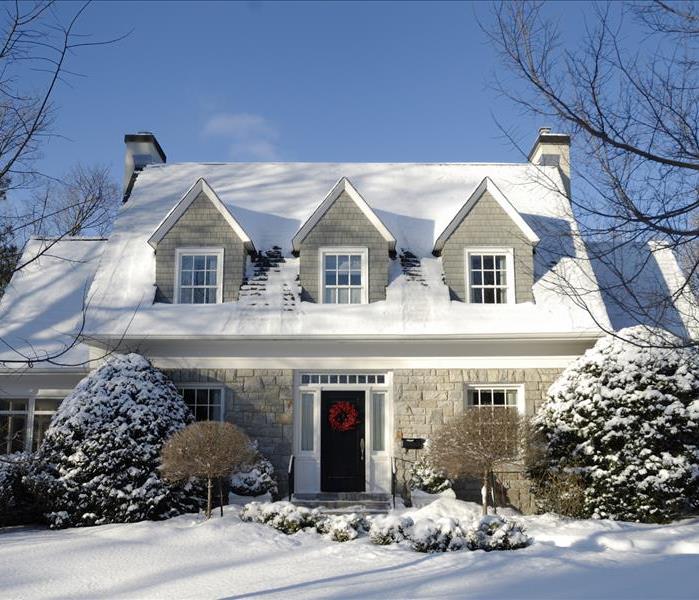 Put a freeze on winter fires.
Put a freeze on winter fires.
Heating, holiday decorations, winter storms and candles all contribute to an increased risk of fire during the winter months.
NFPA and the United States Fire Administration (USFA) are teaming up to help reduce your risk to winter fires and other hazards, including carbon monoxide and electrical fires. Learn more about these specific elements of winter fire safety to help keep you safe this winter.
Heating
Heating is the second leading cause of U.S. home fires, deaths and injuries. December, January and February are the peak months for heating fires. Space heaters are the type of equipment most often involved in home heating equipment fires, figuring in two of every five fires (40%).
Carbon Monoxide
Often called the invisible killer, carbon monoxide (CO) is an odorless, colorless gas created when fuels such as gasoline, wood, coal, propane, etc. do not burn. In the home, heating and cooking equipment that burn fuel are potential sources of CO. Carbon Monoxide incidents are more common during the winter months, and in residential properties.
Winter storms
Most of the U.S. is at risk for winter storms, which can cause dangerous and sometimes life-threatening conditions. Blinding wind-driven snow, extreme cold, icy road conditions, downed trees and power lines can all wreak havoc on our daily schedules. Home fires occur more in the winter than in any other season, and heating equipment is involved in one of every six reported home fires, and one in every five home fire deaths.
Generators
Portable generators are useful during power outages, however, many homeowners are unaware that the improper use of portable generators can be risky. The most common dangers associated with portable generators are carbon monoxide (CO) poisoning, electrical shock or electrocution, and fire hazards.
According to a 2013 Consumer Product Safety Commission (CPSC) report, half of the generator-related deaths happened in the four coldest months of the year, November through February, and portable generators were involved in the majority of carbon monoxide deaths involving engine-driven tools.
Candles
December is the peak time of year for home candle fires; the top four days for home candle fires are New Year’s Day, Christmas, New Year’s Eve and Christmas Eve. Each year between 2009 and 2013, an average of 25 home candle fires were reported each day.
Electrical
Electrical home fires are a leading cause of home fires in the U.S. Roughly half of all home electrical fires involved electrical distribution or lighting equipment, while nearly another half involved other known types of equipment like washer or dryer fans, and portable or stationary space heaters.
Christmas tree disposal
Christmas trees are combustible items that become increasing flammable as they continue to dry out in your home. Nearly 40 percent of home fires that begin with Christmas trees occur in January. Although Christmas tree fires are not common, when they do occur they’re much more likely to be serious.
Source: http://www.nfpa.org/public-education/campaigns/put-a-freeze-on-winter-fires



 24/7 Emergency Service
24/7 Emergency Service
































